
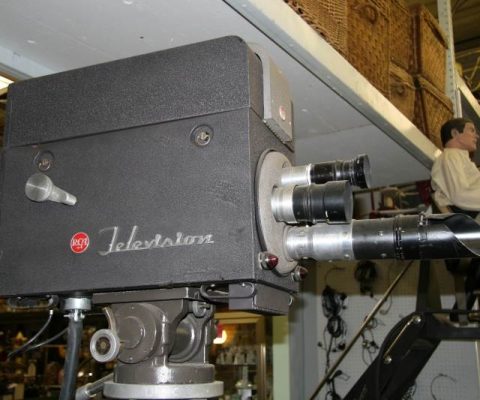
HISTORY FOR HIRE: A Grand Tour of Hollywood’s Top TV Prop House
In February of 2011, Concord, California camera collector John Bolin took a tour of Hollywood’s top ”prop’ house, History For Hire. By taking his camera, he took us all on tour with him. John sent me over 100 photos of his visit, but I’ve included only about thirty here because the place is so huge, even John’s 100 plus images can’t do it justice so I’ve chosen only the ones that have cameras in them, and not even all of them. There are nearly 1000 microphones that cover every era, different size cranes and dollies, pan heads and peds galore and even a few Mole Richardson perambulators (sound booms).
Basically, if you can name it, History For Hire has it buy the hundreds, and if not, they can make an exact duplicate…even cigarette packages and bottle labels. Got a war scene? Pick a war, and they can outfit your armies…they even have replicas of “Fat Man” and “Little Boy”, the atomic bombs used in World War II.
Below right is John and his wife at KRTH radio where they had gone to visit a friend…afternoon driver, Shotgun Tom Kelly (with hat). It was a busy trip for the Bolins because they had gone down to Los Angeles to pick up a TK47 (new add to his collection) from my old friend Manny Rodriguez whom I met at ABC in New York in the late 1980s. For a long time, Manny was the director of the “Ellen DeGeneres Show” , but is now directing the CBS mid day show “The Talk”. They went to the taping of The Talk. Later that day, they went to the taping of The Conan Show and visited our friend Bruce Oldham who is on camera three. Bruce and John went to school together.
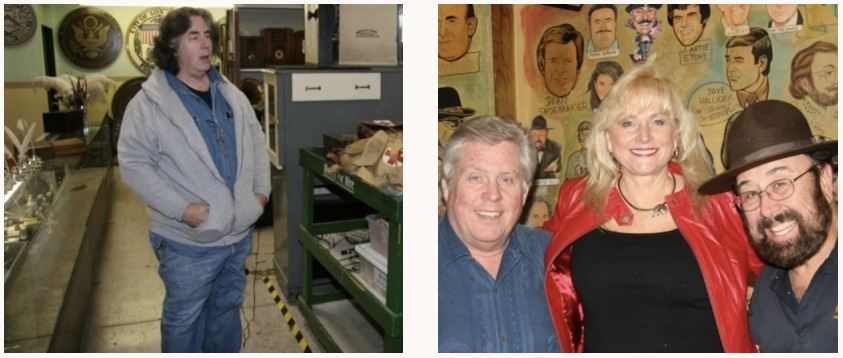
Above left is History For Hire owner, Jim Elyea. Chuck Pharis has helped Jim collect and reengineer cameras over the years and told me stories of how big the place was. Jim and I became friends last year when I helped him acquire 3 pristine Vinten Fulmar pedestals from Singapore. A collector there had short circuited their trip to the salvage yard and need help in finding them a new home. They have a new life in Hollywood now, and at this writing, the 3 peds are being used in the new Muppet Movie.
Before I lay out all the shots below with just a few comments on them, I’ve got to show you a very neat trick. I think Chuck Pharis taught Jim how to do this when they were building the three prop cameras used in American Dreams, which was a TV series that revolved around the early days of American Bandstand. You can see them below in a few pictures.
Since there are basically no working cameras from these early eras, they have to look like they are working, so all the old insides are taken out the real cameras, but saved for parts for collectors. That means little flat panel LCD screens for the view finder, and to make the illusion complete, not one, but four little lipstick cameras with different focal lengths, to imitate the different lenses on the turret that changes in the viewfinder when you rack the lenses to a new position.

Look carefully at the photo above. First, this is NOT a real TK30. All of Jim’s other cameras are real, but oddly, he has no real TK30s, so he had to make some, but that’s not why I’m showing you this.
See the small box under the lens turret on the bottom of the camera? It’s very non descript and looks like it could be one of the many modifications made to these cameras. Now…look below. The front of the box is open and shows the four small lipstick camera lenses that feed a picture to the LCD viewfinder screen and even to monitors in a control room if that is what’s called for. When the turret turns, there is a mechanism inside the hollow camera body that changes which lipstick lens is ”taking’ the shot. All of his cameras have this capability. Cool!
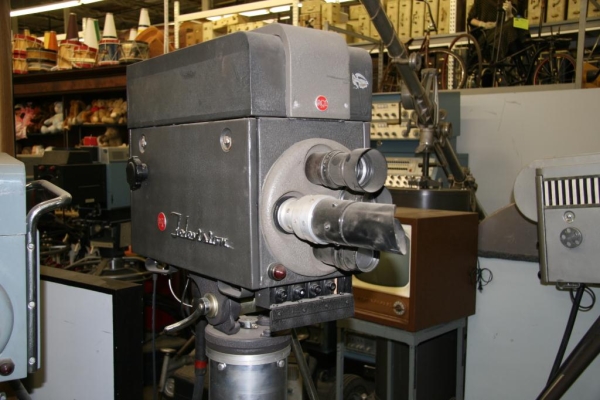
OK…here we go…enjoy!

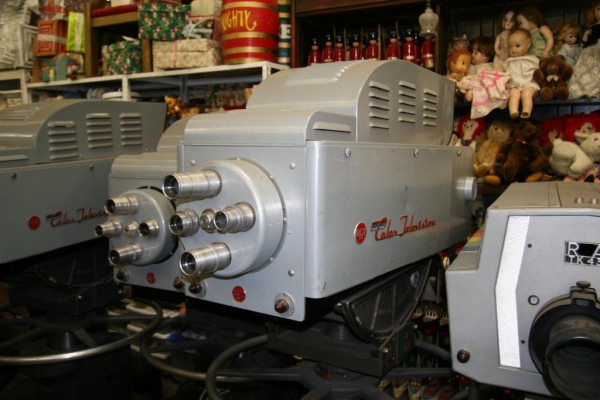
These 3 TK41s above are from CBS and have the lipstick cameras, too…all the cameras have them, even the TK42s below.
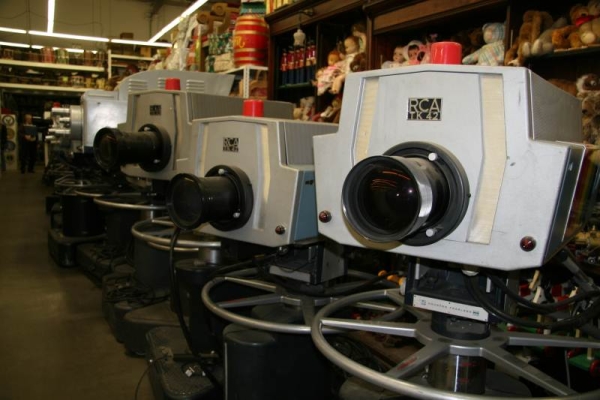

WOW! Camera Row!

Above, are the cameras built for “American Dream” , and again below behind a real TK10


Above, a real TK10 and below, a real good copy of a TK30 on a Panoram dolly

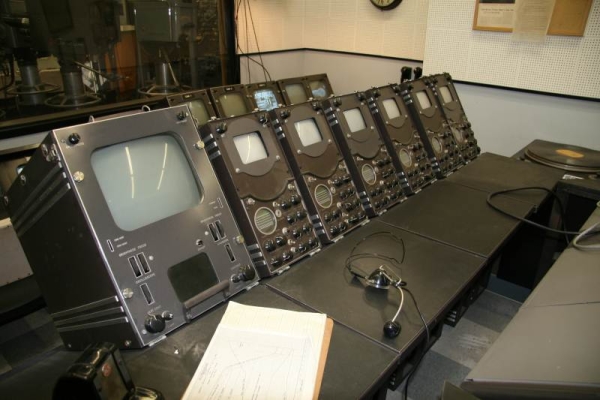
Believe it or not, this is a History for Hire built 1950s control room console, and it works.

Above, John’s friend Bob Snyder on Camera Row with TK60s, below, Norelcos!

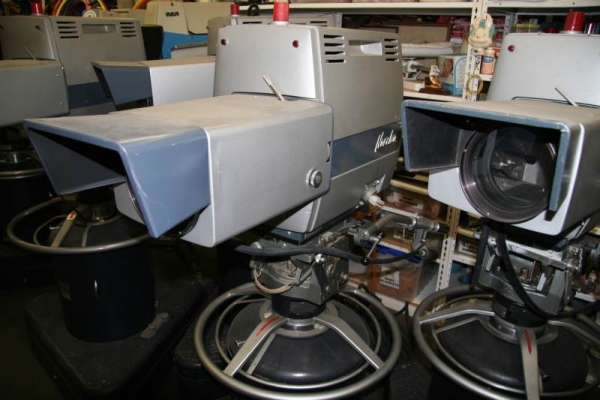
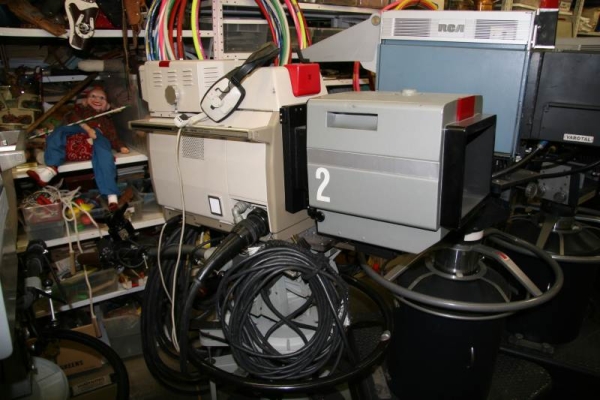
Above I see an Ikegami 323, TK44s and Howdy Doody? Below is one of their TK46s.








Below are Ampex mono tape recorders…a sight near and dear to my heart. This is what I used in my first days in radio in 1964. I’m still a great audio editor and these machines are one of the reasons why…it’s where I learned to splice and edit.

Surprise! MSNBC Primetime Convention Coverage Was From NYC!
Surprise! MSNBC Primetime Convention Coverage Was From NYC!
Who knew? I watched MSNBC a lot, and it was just like Brian Williams and Rachel Maddow were there in the hall. Actually, they were in MSNBC Studio 3A, in a the space usually occupied by the “Morning Joe” set.
The seamless blending was made possible by the large number of isolated camera feeds (via fiber optics) from the locations, that give the 3A control room the ability to operate as if the video sources were originating inside 30 Rock. With the giant LED wall screens behind them, using the iso camera from NBC News booth in the hall made it totally believable. Kudos! -Bobby Ellerbee


THANK YOU…AGAIN From Eyes Of A Generation!
THANK YOU…AGAIN From Eyes Of A Generation!
Yesterday, this page hit a new all-time-high weekly Post Reach of 420,277!
That is nearly double the number in Wednesday’s thank you post, for the new 225,061 threshold, achieved then. We’ve also had 361 page likes this week which gives us 9,077 members who have made “The Home of Television’s Living History”, their home too.
As I have said, I am not the one that makes it live…you do. I do my best to memorialize historic, or interesting moments in TV, but it is all of you who bring the life to it by adding your input, much of which is a rare first hand narrative from people that were there. Thanks also for the amazing images that you so generously share with us. Most of all, I thank you for your willingness to teach me, and all that come here, from the fullness of your experiences, which include every area of the broadcast industry. -Bobby Ellerbee

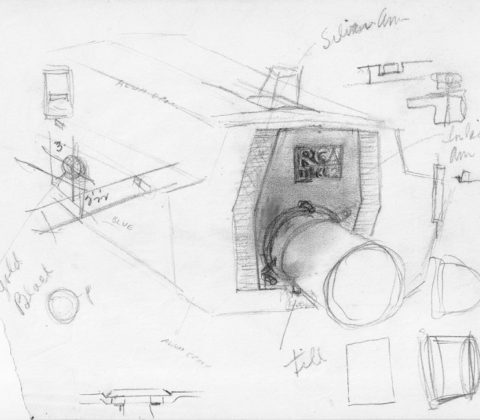
The Virtual Archives of RCA Engineer Harry Wright
He helped design the RCA TK42, TK42XX, TK43, TK44, TK47, TK48, TK76 and more.
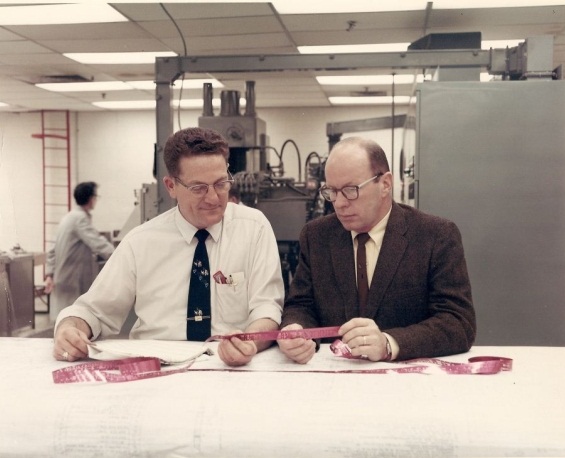
The man in the suit is Harry Wright, one of RCA’s most respected mechanical engineers.
I had the privilege of getting to know the man who designed some famous cameras for RCA, Mr. Harry Wright. To get things started with a big bang, here are the first ever, hand drawn images of two of those cameras.
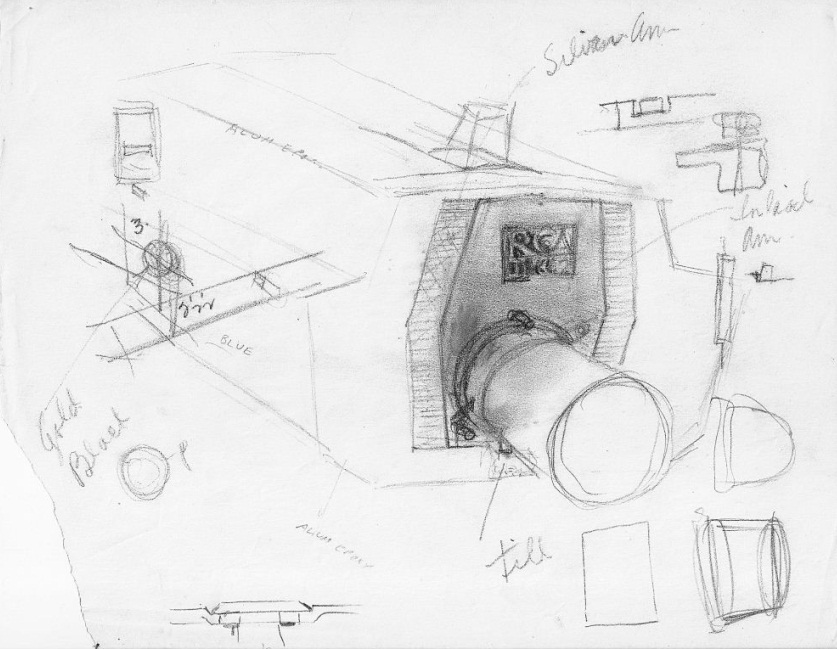
This is Harry’s first rough sketch of how the RCA TK42 should look.
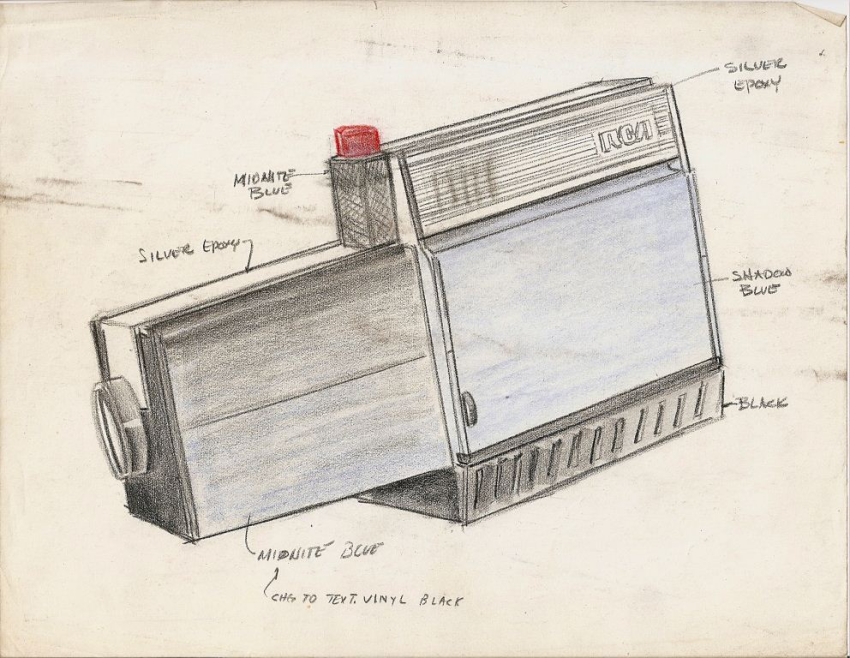
Here is Harry’s first sketch of the TK44.

Here are some of Harry’s ideas on a new viewfinder hood for the TK44.
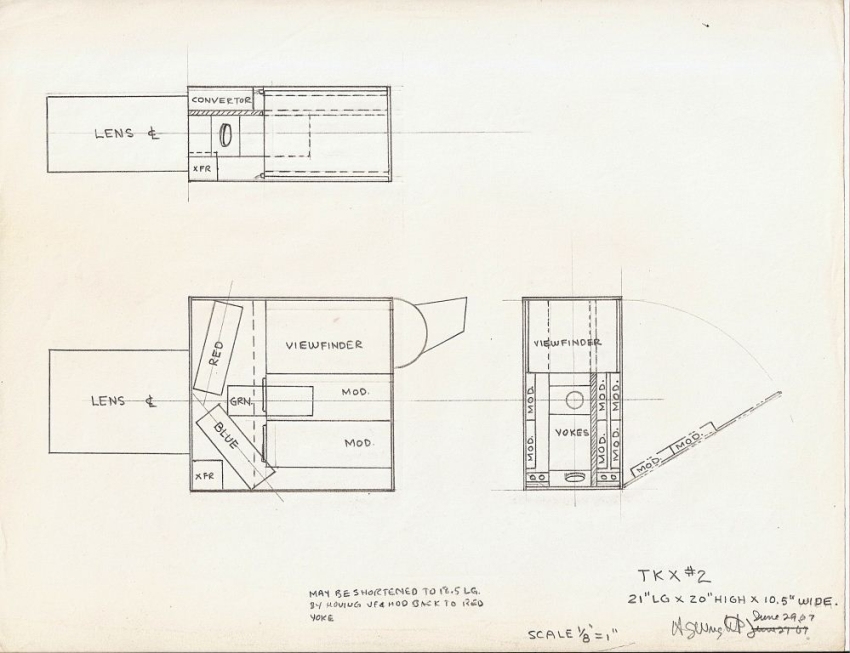
This simple schematic from June 1967 lays out Harry’s first thoughts on the internal construction of the TK44.
WOW! Great stuff, isn’t it? I have about a dozen more of the first detailed schematics of the TK42, 42XX, 43, 44 and 45 cameras that I would love to show you, but they are huge, blueprint size 20 x 30 inch sheets and too big to display here.
If you are curious about the TK42XX as mentioned above and wonder what in the world that is, well, take a look…perhaps your first ever at the dual-lens TK42 experimental camera below.
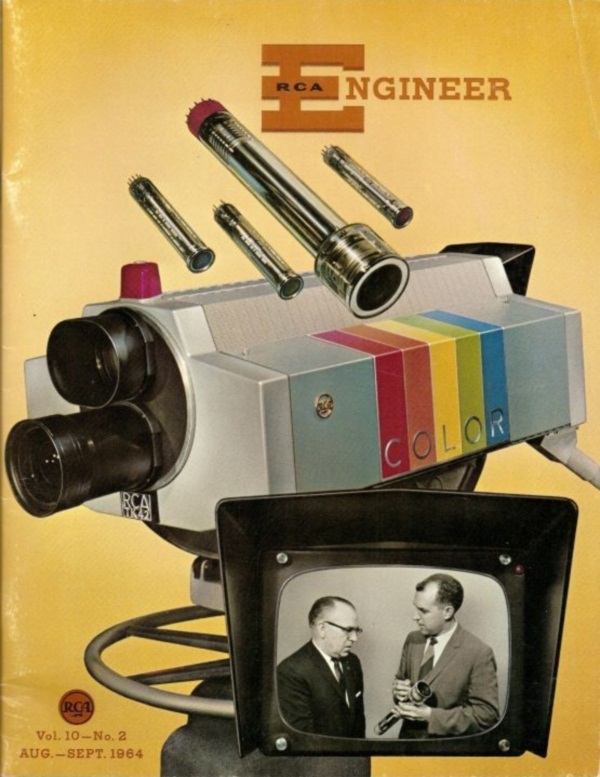
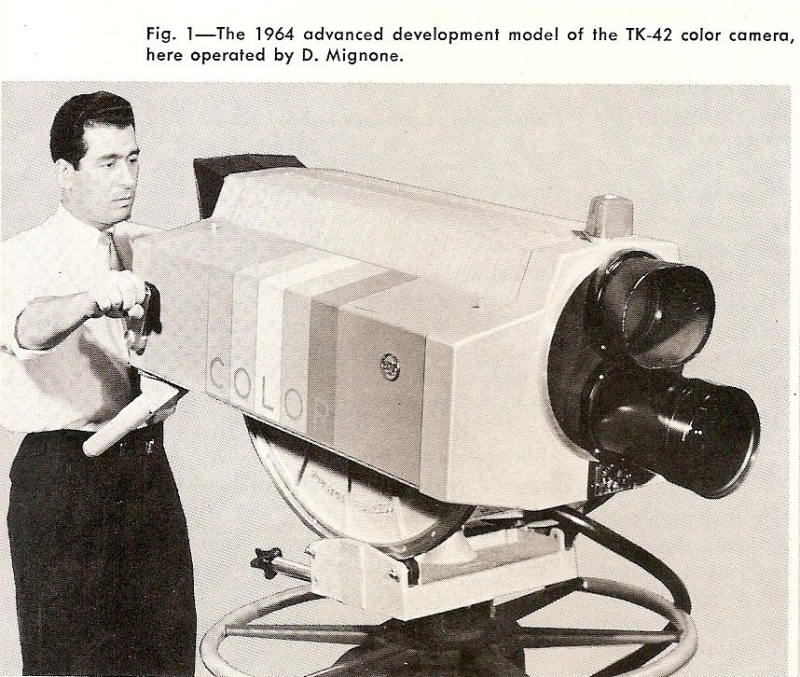
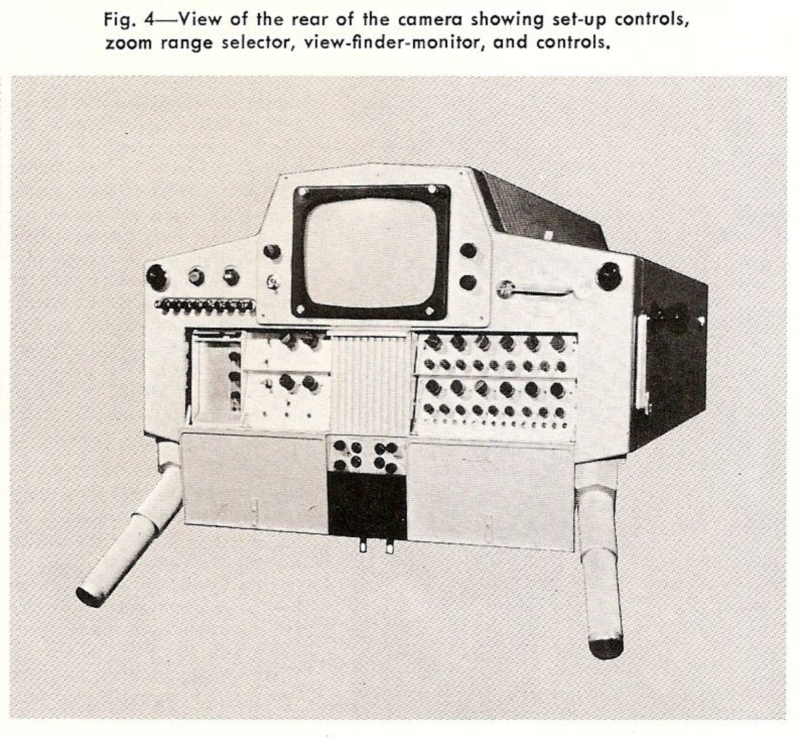
Above, you see the finished product…the RCA TK42XX dual-lens camera, and although it never was put in production, it was built. To build one, you have to have plans, and below is one of Harry’s early schematics of the TK42XX from October 1963.
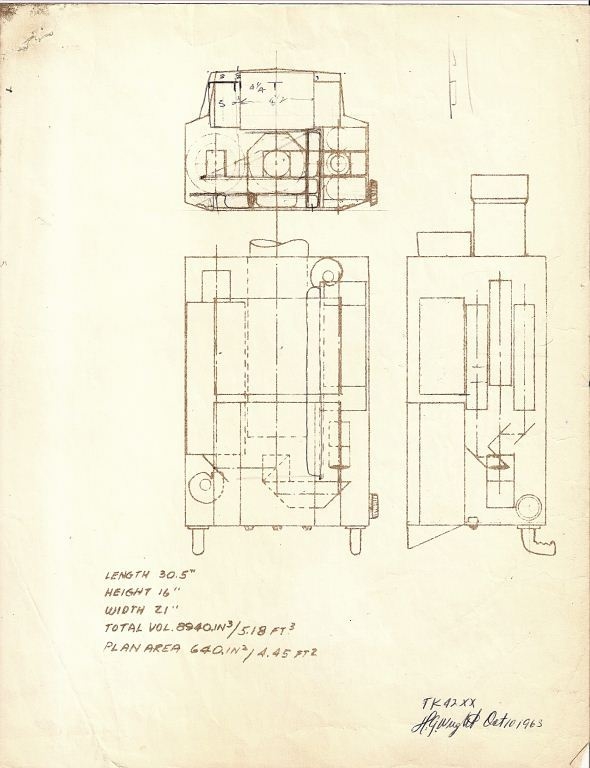
Before we go further, I want to comment on the first image on this page…the one of Harry looking at a red plastic tape. In that photo, he is double checking the information on the dot coded ‘instruction’ tape for the new, automated three-axis lathe at RCA. The project he is working on is the front face panel of the TK44 plumbicon camera. Just below is the three-axis lathe and below that, the finished product, the TK44 face plate.
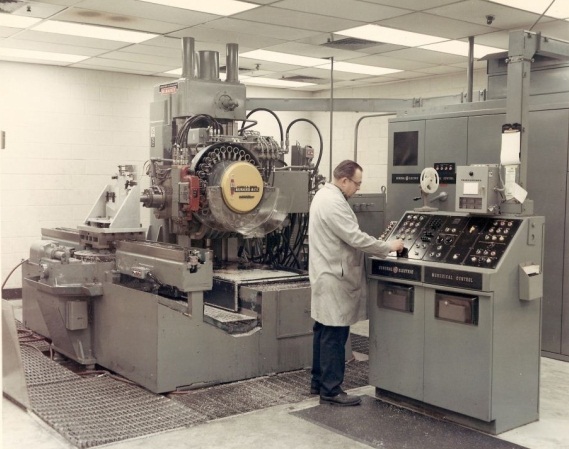

Below is the first mock-up of the TK44 from RCA’s art department. Harry’s copy shows that he knew some top vents would be necessary, so he drew them in on his copy; later, Harry came up with the hinged top door with horizontal vents.

Among the papers and photos Harry sent are some delicious, never before seen images from the RCA engineering lab in Camden where each camera’s first editions were built. Below are photos of TK42 and TK43 cameras in that lab, in various stages of their initial mock-up construction and completion.

Looking closely above, you can see the Varatol 3 internal lens sticking out of the camera body though the lens hole as the first TK42 is constructed. This was the TK42s Achilles heel of sorts. With the lens now inside, the heat of the electronics affected the internal mechanics of the lens and made the zoom process unreliable at times when the lens elements expanded and ‘chattered’ instead of gliding smoothly. Note that the images had to come all the way to the back of the camera before being split up and sent to the optics side of the camera (right side) as seen below.
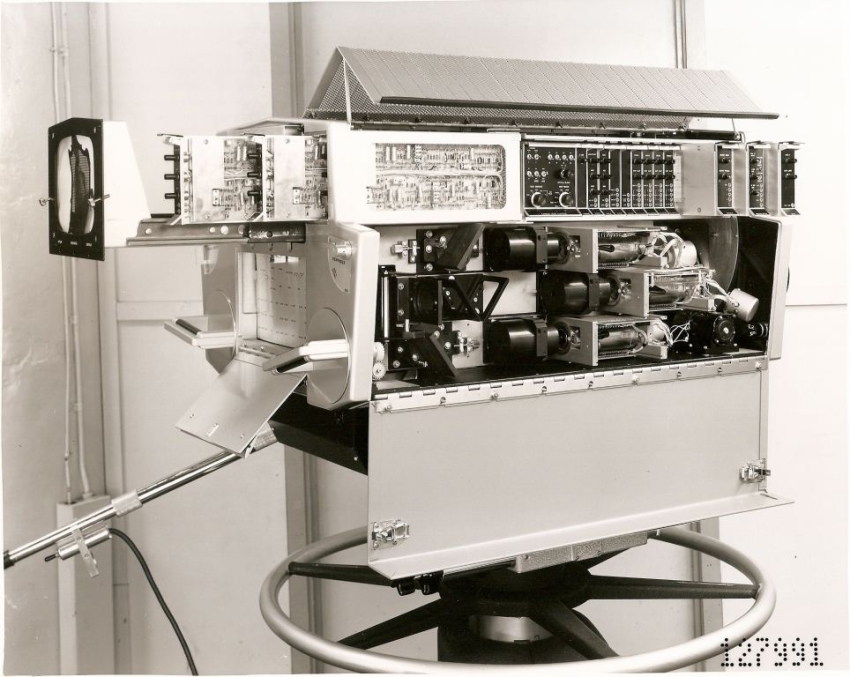

Here is a close up of the Varatol 3 lens used in the TK42 and 43.
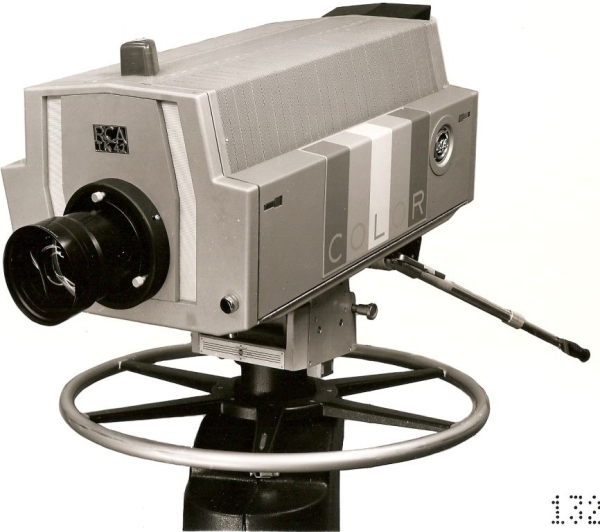
Above is the art department’s final version of the TK42 and below is the engineering lab’s final version as it sits finally mounted, ready for testing. Below that is a close up of the mock-up camera from the operator’s position.
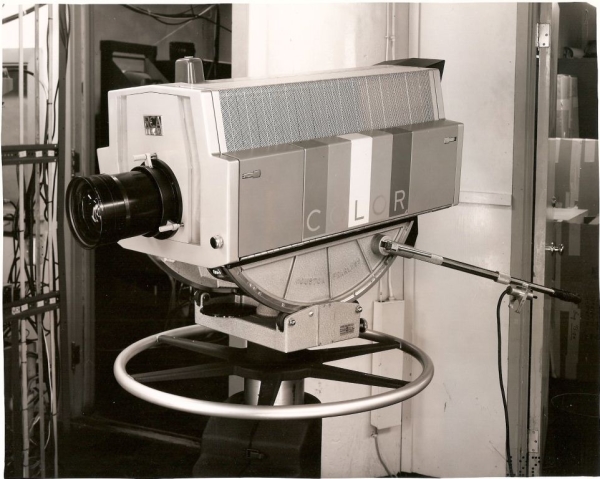
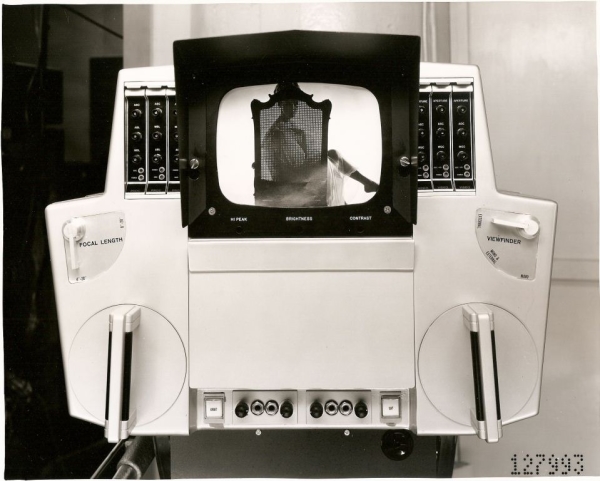
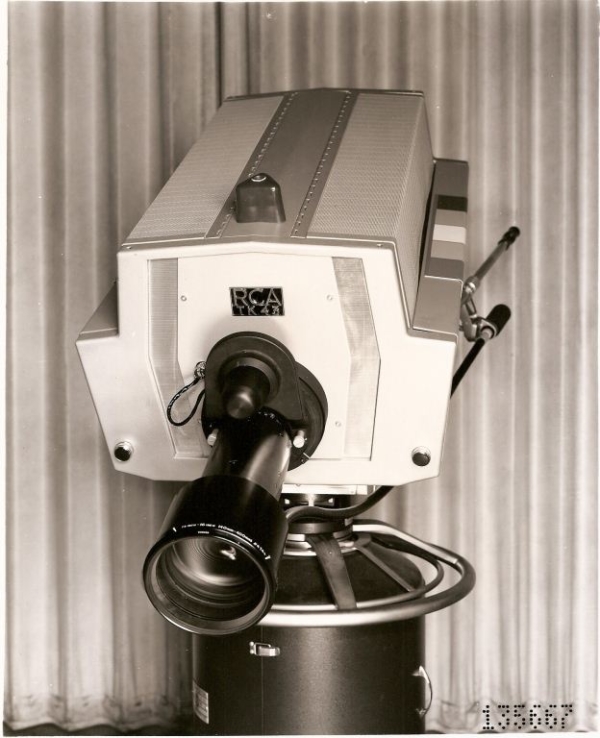
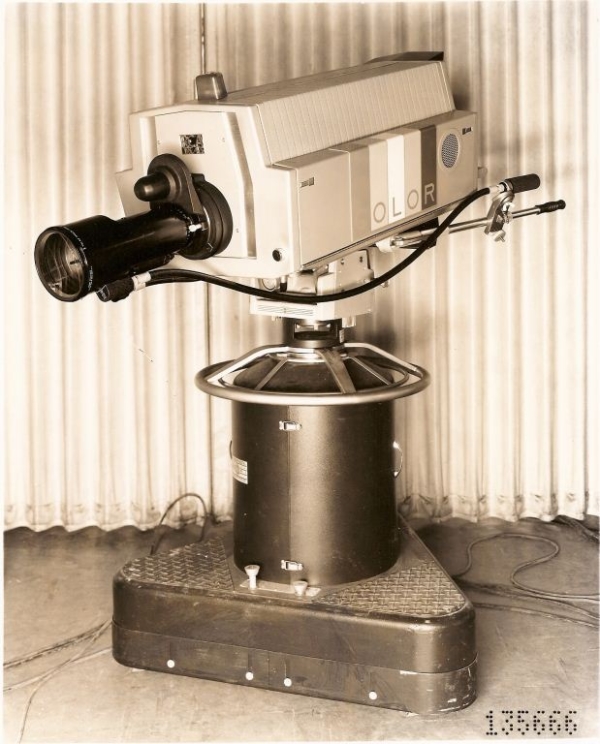
Above, two images of the completed TK43 in the Camden RCA lab and below, two close ups of the front of the 43 without the Varotal 3 external lens.
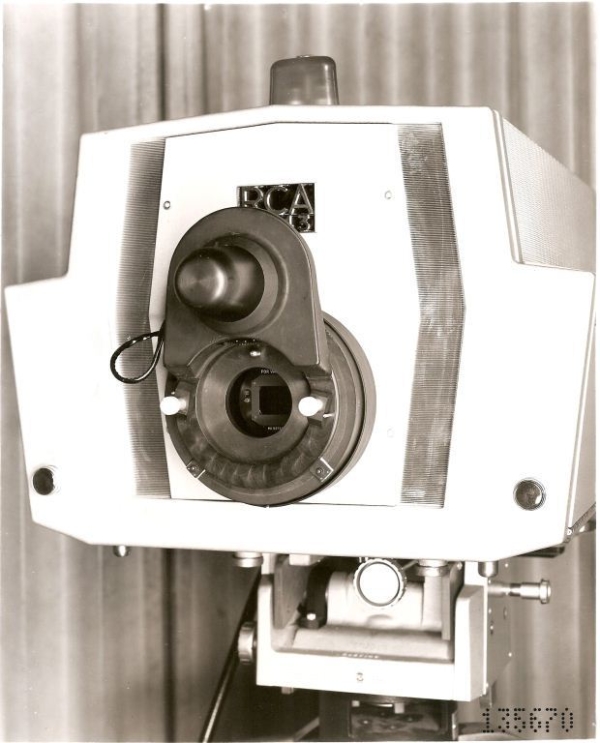
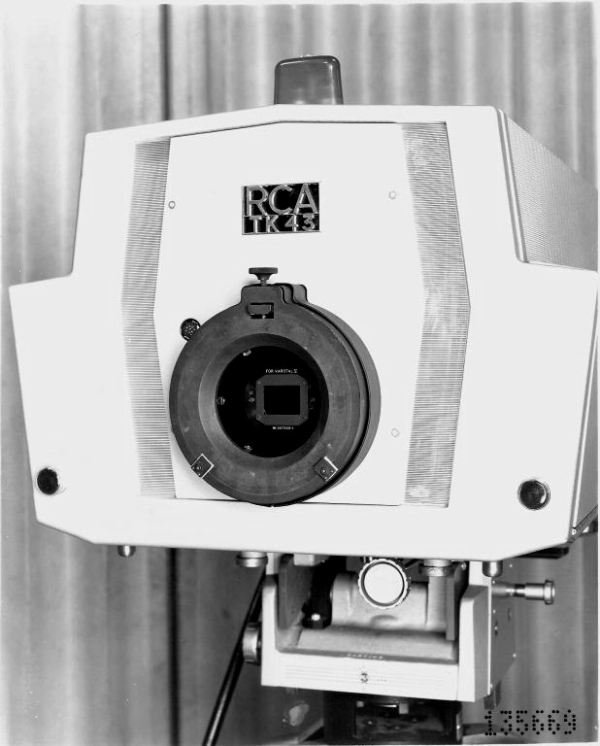
Now to something that, to me, is quite interesting. Unknown to most is the name Fred Himelfarb, but his name is something you cannot avoid in the historical discussion of color television at NBC and RCA, and even Norelco. As you can read on the TK41 Camera page top, Fred was a driving force in the development of how color cameras were built and operated. Fred came from RCA to NBC with the first TK40s and was the official ‘man in the middle’ between NBC and RCA on all their cameras. Below is a memo that Harry was included on, and it’s all about what Fred thought of the RCA TK42 after a visit to Camden on May 5, 1964.
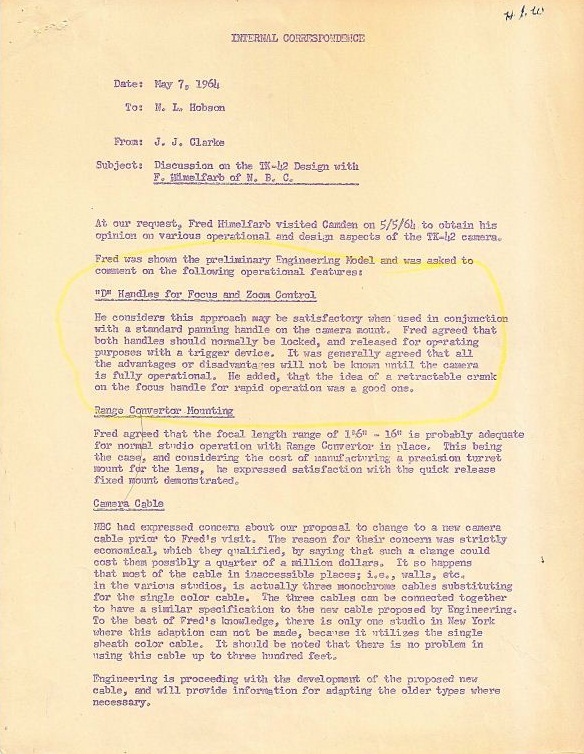
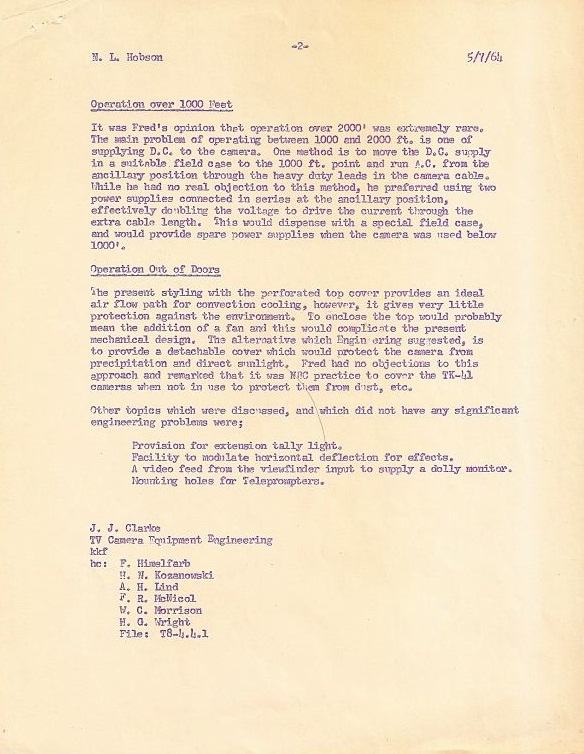
Item one in the memo is the D handles on the TK42. These were designed by Harry Wright, and if you read the TK42 page on this site, you will see that there were very mixed emotions about this new ergonomic addition. Harry was actually kind of in the dog house for a while, but not for long. Item three deals with camera cables and the expense of changing them and accessing them at NBC’s 30 Rock headquarters. What is interesting about this is Fred is the one that came up with the single cable fix on the TK40-41s that eliminated the bulky and excessive three-cable setup that each camera required early on.
Finally, although Fred did not condemn the TK42, he did not praise it either. Matter of fact, NBC never bought a single TK42 or 43, HOWEVER, below are the only known pictures of one of two TK43s RCA “loaned” to NBC NY and never came back to pick them up.
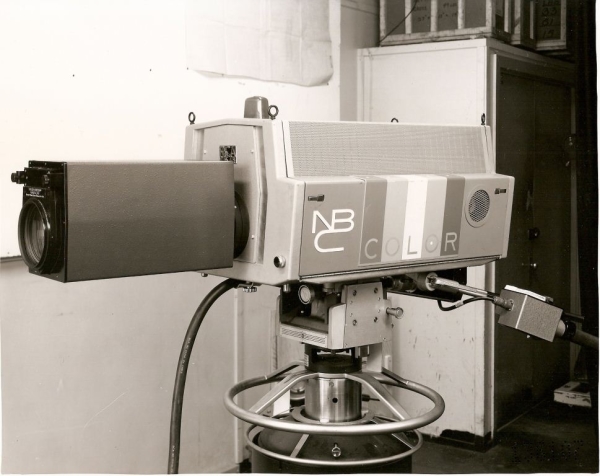
This is one of two TK43s that were delivered to NBC in New York by RCA as loaners. Fred told me they came in the day before a big election so the plan was to put them to work on the election set. Try as they may, they could not get them the pictures right before air time, so they put the logos on them and used them as prop cameras with cameramen behind them on the set just to make it look good. They eventually wound up in a small ‘always hot’ news studio with the cameras on 24 hours a day just in case there had to be a live news bulletin from an NBC news reporter. I think that studio was also used by WNBC for a 1:30 AM newsbreak. The unusual looking lens is believed to be an experimental Varotal Mark XIV with possible a 16 to 1 ratio. No one knows what ever happened to them.
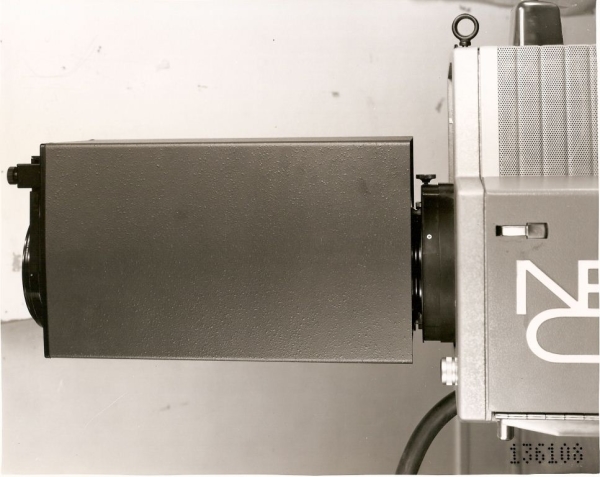

Well, well, well. What have we here? Above and below are the only two known images of what are believed to be an early prototype of the TK47 camera. I like this a lot better than the final version of the TK47.
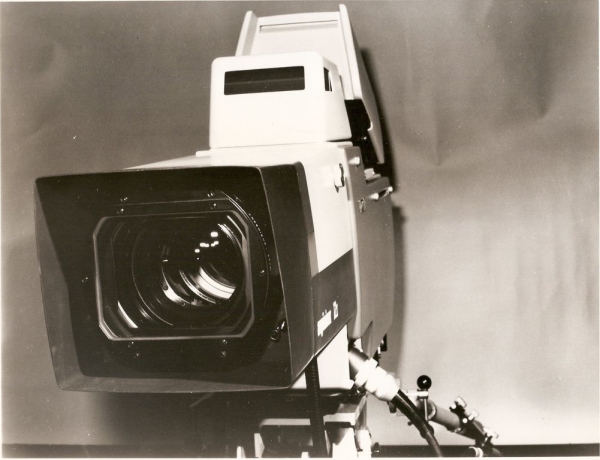
Although I wish my friend Chuck Pharis luck in finding one of only two TK48s ever made, here is something almost as rare: an RCA promotion piece on the elusive, never-manufactured TK48 Studio Camera. Below is the full document with all the features and details, and below that is a close up of the image.
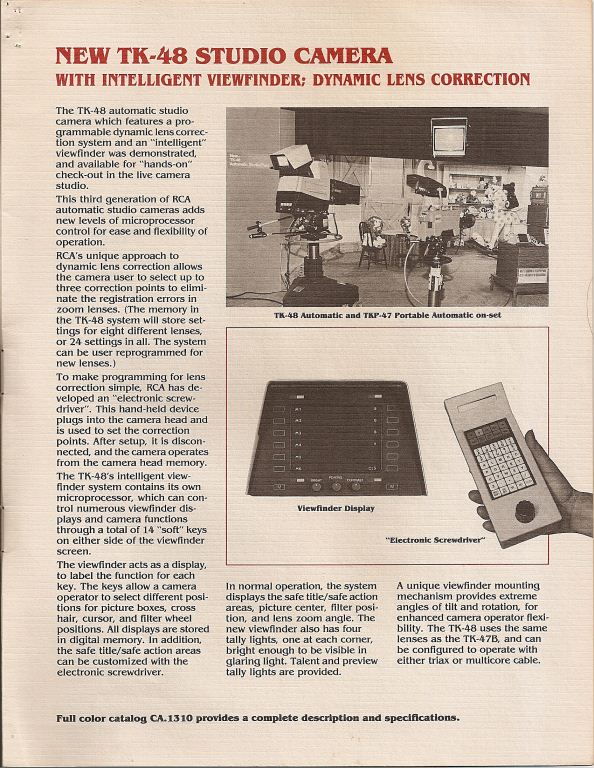
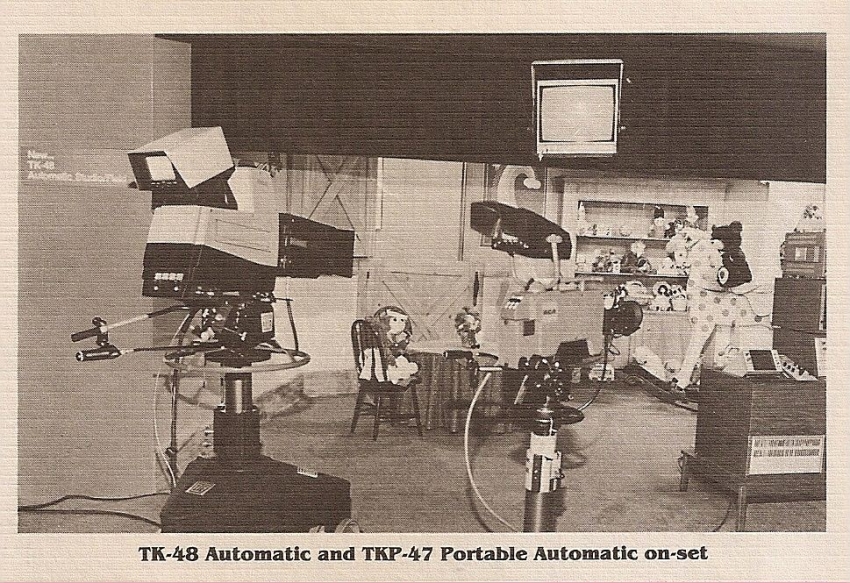
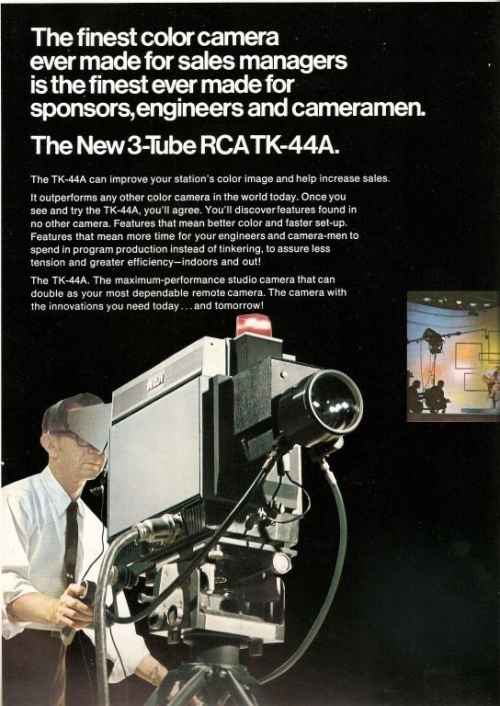
Above is an ad for the TK44 and below an ad for the TK47…oddly, the only RCA studio camera to ever win an Emmy Award.

In closing, I need to mention that early on at RCA, Harry was quite involved in telecine camera creations and worked on many projects during his many years there. He started as a young pup and worked for RCA his entire carrier and left with a bang! One of Harry’s last projects was a camera that changed everything when it debuted in 1976. It was the RCA TK76 ENG camera (thus the 76 in the name), and if you look at the RCA ad below and think of how Harry’s designs always demanded that RCA cameras be rugged, you can understand how this camera survived a fall from an airplane and continued to work. There is much more to the Harry Wright story, but I feel fortunate and privileged to be able to tell part of it and to know him. Thanks, Harry, and God Bless You!

Since Harry has such a good sense of humor, I want to leave you with one last thing. Below is an official RCA memo of ‘thanks’ to the people involved with the TK47 project and the less than lavish memento given to them in appreciation for all their hard work on this Emmy Award winning camera. It’s kind of funny and kind of sad, but, such is life!
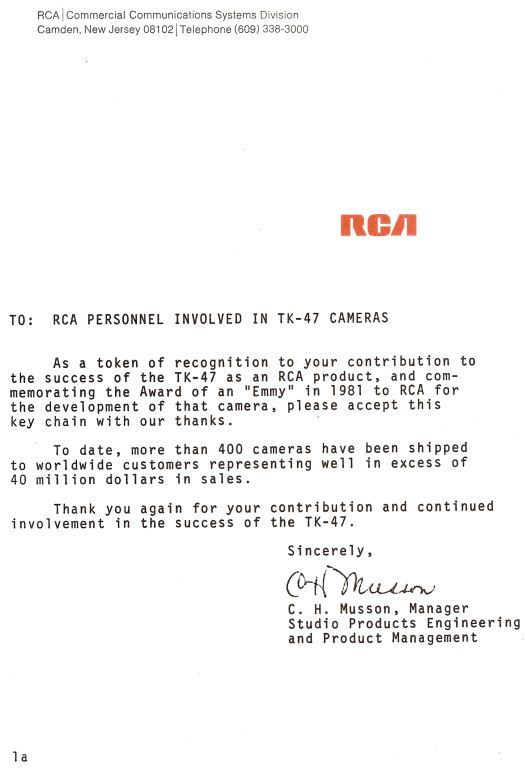
July 30, 1943…RCA Announces Sale Of NBC Blue Network To Ed Noble
July 30, 1943…RCA Announces Sale Of NBC Blue Network To Ed Noble
It would be October 12th before the FCC approved the deal, but July 30 was the day they agreed on the $8 million price, but would you believe that Noble actually only paid $7 million? It’s true, and here is the story.
RCA head David Sarnoff had been very firm on the asking price, even as bidders including such luminaries as Chicago’s Marshall Field, the Mellon family, McGraw Hill and Paramount PIctures balked at the price. Edward Noble owned the Lifesaver candy company, and was also interested, but was also balking.
Finally, a man that had started with NBC’s WEAF as an accountant in 1922, came up with a plan. His name was Mark Woods, and as VP of the Blue Net, he had overseen the fiscal separation of Red and Blue assets that became official on January 9, 1942, a year after the court ordered breakup.
Woods saw a chance to do something for the man who was apparently destined to be his boss, so he did it. Noble wanted to pay $7 million, instead of the $8 million RCA wanted. To make it happen, Woods went to Sarnoff and discussed an RCA sponsored series to run on the Blue net in the first year after the sale. Wood’s idea included $650,000 in air time, and $350,000 in talent costs. Sarnoff went along with the deal that allowed Noble to recoup $1 million on the sale. It was, at the time, the largest sale in broadcasting history. For those to young to know, this is the beginning of ABC. Enjoy and share! -Bobby Ellerbee
Rare Jack Paar Images…A Camera In A Limo? Yep, And MORE!
Rare Jack Paar Images…A Camera In A Limo? Yep, And MORE!
On this Anniversary of Jack’s ascendance to host of the “Tonight” show, here are a few real pictorial rarities.
ABOVE: On July 29, 1957, Jack became the host of “TONIGHT”but before that he was a CBS man, starting in ’54, he had been the host of the CBS morning show. On November 22, 1957, Edward R. Murrow interviewed the new NBC man, live on “Person To Person”. Since there is no video, we don’t know if the limo moved, but none the less, they did part of the interview from inside the car. That would have been very hard to do with cables and all, but WOW…it would sure have been interesting to see!
This is from the first year in NBC Studio 6B, in 1960, after the move from The Hudson Theater. I think by the time the show went to color in September of ’60, the studio was redone because it looks pretty beat up here.
This is the only still image I have ever seen of the moment Paar walked off the show, after shaking hands with Hugh Downs, who had to take over then. There was a video tape of this, but I think it is long gone, and I would bet this is from a replay of the show later that night. Thanks to some enterprising crew member, we have a shot of it.
This is the set Paar inherited from Steve Allen at The Hudson Theater and is from the third month of the show. Seen with Jack are staff members, plus announcer Hugh Downs and Cliff Arquette (aka Charlie Weaver). (back row standing l-r) Writer Walter Kempley, program feature editor Chris Carrol, talent relations Tommy Cochran, assistant to Jack Paar Mitzi Matravers, unit manager John Carsey, floor manager John Lynch, Marty Morgan, program manager William Levi Anderson.
From 1958, this is Jack’s second “Tonight” set at The Hudson Theater. I think this was added in early ’58.


CBS Field Sequential Color Cameras at Studio 57
Below I have collected more than twenty images of the fabled CBS Field Sequential Color cameras in action. Until their debut here, these images have not been seen like this before. Below, Ed Sullivan prepares for his part in the production that is documented in this one-day sequence of photos.

This page is mostly about the cameras and some history, but the full technical story, beautifully told and impeccably accurate, is available at Ed Reitan’s great site. http://www.earlytelevision.org/Reitan/index.html
Other parts of the Ed’s posts and research include the entire story and chronology on the great battle between CBS and its Field Sequential Color System and RCA’s Dot Sequential Color System, and how we morphed into the NTSC standard.
It should be quite obvious that these are retrofitted RCA TK10s, but I’ve just recently discovered the two images below. At top, we see a prototype of a different color camera configuration that possibly anticipates strong pushback from RCA on the CBS customization of its TK10 design. Below that is a photo of the console that controls each camera. The camera appears to have two lenses on a hinged front, and on the camera’s left side, there is what looks like a Mitchell movie camera viewfinder.


In the photo below, you can see the color wheel just behind the turret in a place you would normally find the filters. That color wheel has alternating clear film sections of red, blue and green filters and spins to give an effect similar to this, but much faster.

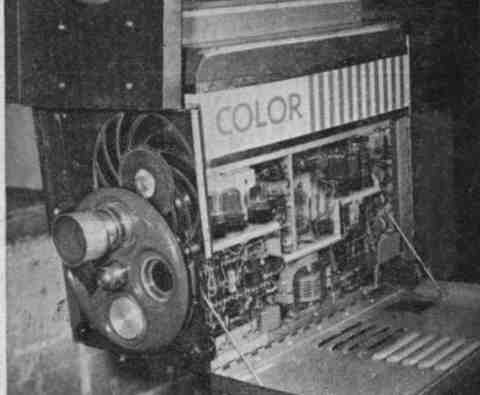
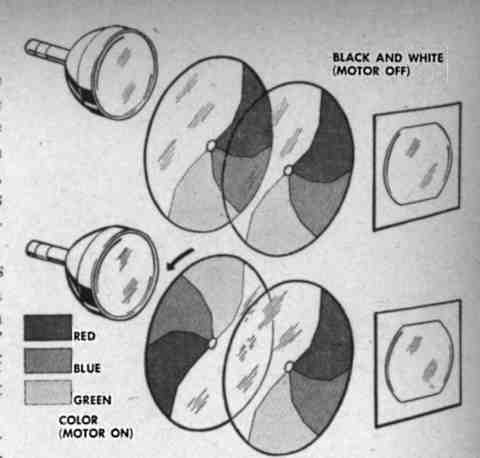
On the other end, there is an identical mechanism in the home receiver and you can see a trial version of it below. The broadcast signal has an embedded timing pulse to synchronize them.
Interestingly, this story is a lot like the one told in the NBC 8G Camera section of this site. Both prototype cameras had their own studio, were built by network engineers, and in limited numbers. There were four of the 8G cameras, but I can only identify three of the CBS Color cameras and only by their left side (operator’s left) vent systems. One appears to have no left door vent, one has a vertical row of center vents, and one has a wire mesh configuration.
These photos are from Life Magazine and the only reference was the date of June 1951. Using the information from Ed’s CBS Color Programming page, I believe these pictures were all made the same day…probably June 24, 1951, at the final dress rehearsal of Premiere. The air date was the next day, June 25th from 4:30 to 5:30, and it originated in Studio 57 (not to be confused with the current Studio 57 at the CBS Broadcast Center).
CBS Color Studio 57 was located at 109th Street and 5th Avenue. The host for the first half-hour was Arthur Godfrey, while Ed Sullivan handled hosting duties for the second half. Among others on that day’s show, there was Faye Emerson, Garry Moore, Robert Alda and Isabel Bigley (stars of Guys and Dolls), the New York City Ballet, William S. Paley (CBS Chairman) and Frank Stanton (President of CBS), with Archie Bleyer and His Orchestra (the house band for Arthur Godfrey’s programs). FCC Chairman Wayne Coy also appeared, talking about the FCC’s decision on color and praising the “hour of triumph” for CBS…but, given what would soon happen, those words would ring hollow.
By the way….the crane cameraman here went all the way up the corporate ladder, to become a very valued VP of CBS Sports. His name is Harold Classen.
(All photos below courtesy of Life Magazine).

The first thing I noticed in this shot was that everybody is hot and mopping sweat. I’ve heard it got so hot in there the floor buckled. This is June in New York with massive lights in a huge studio with NO air conditioning.

With monitor in view, this crew member sits on the pedestal of one of the cameras. Notice the metal mesh-like sides on this camera. As we go along, you’ll see that every camera had different side panel modifications for cooling.

Before we get too far along with the cameras, remember that the CBS Field Sequential Color system worked on the basis of a synchronized spinning color wheel. There was a wheel in the camera and a wheel in the receiver…eventually. I’m guessing here, but this seems to be a external color wheel distributed for home demonstrations of the CBS color broadcasts, as I don’t think there were any receivers in 1951 with the wheel inside. Only a few hundred were ever made, and then were actually recalled.

Host of the first half of Premiere, Arthur Godfrey, in a Ritz live spot run-through…

…and performing “On Top Of Old Smoky.”

Given what I’ve seen in the full set of pictures, I believe there may have only been three of these cameras. The one mounted on the Sanner crane has vertical center vents on the left door vent, one of the cameras has the partial wire mesh door, and the camera below seems to have no vents in its door.


CBS Chairman (in the crane chair…naturally) William Paley and CBS President Frank Stanton as guests on the Premiere debut show.

Co-host Arthur Godfrey and guest star Faye Emerson are getting along famously. Godfrey was already famous for his radio and television programs, but Faye Emerson was a big star in her own right. Referred to as “Mrs. Television,” she was a well-rounded entertainer, and such a ‘natural’ that she even hosted two late night talk shows in 1949…one on CBS and one on NBC. Wow! For more on Faye’s very interesting life, click here.

Above and below, Faye Emerson shows off colorful paintings by Picasso, Renoir and Hopper, on loan from the Metropolitan Museum of Art and the Museum of Modern Art.


Above, Isabel Bigley and Robert Alda perform Irving Berlin’s “You’re Just In Love” from the musical Call Me Madam.

Members of the New York City Ballet, under the direction of George Balanchine with staging by Sol Hurok, perform Maurice Ravel’s La Valse.
From here on, I’ll just let the pictures below explain themselves with no further captions.



Backstage With Jack Paar..”Tonight”, December 7, 1958
Backstage With Jack Paar..”Tonight”, December 7, 1958
Today is the anniversary of Paar’s debut as host of the show and to help celebrate, here is a rare treat is in the form of a “New York Times” article by John Shanley gives us a look behind the scenes of “Tonight” with Paar as host. That I know of, there is no online kene footage of Paar hosting the show from The Hudson Theater, and there are very few photos from the Hudson years.
Below left is the full article, but that is hard to read, so I cut the article into two pieces which makes it easier to read.
On January 12, 1959, the show began being videotaped for playback the same day. In January of 1960, the show moved from The Hudson to NBC Studio 6B and color broadcasts began September 19, 1960. Thanks to Paul Jacobs for the article. Enjoy! -Bobby Ellerbee
July 29, 1957…The Jack Paar Era Of “Tonight” Begins
July 29, 1957…The Jack Paar Era Of “Tonight” Begins
Location wise, the “Tonight” show with Jack Paar started where Steve Allen left off…in the Hudson Theater, but the final show from there came the week the 1950s ended.
The first week of January 1960, the show’s new home would be NBC’s Studio 6B. The show went color September 19, 1960, but on January 12, 1959, while still at The Hudson, the show had begun being videotaped. For the first few months of taping, Paar did the Thursday night show live for some reason, but before long that ended and over the years, the taping time moved from 8 PM till 6:30 PM.
Steve Allen hosted his final episode of Tonight on January 25, 1957. The following Monday, NBC debuted a new multi-hosted, magazine show in the time slot…”Tonight: America After Dark”. It was an instant flop and they hurriedly began searching for someone who could do a new version, that was more like the old version.
The logical choice might have been Ernie Kovacs, who’d hosted two nights a week during the final months of Allen’s run, but Kovacs had moved west and was appearing in movies. Instead, they picked Jack Paar, who had hosted an array of short-lived programs for all the networks in the preceding years.
Paar got his first tastes of television in the early 1950s, appearing as a comic on “The Ed Sullivan Show” and hosting two game shows, “Up To Paar” (NBC) in 1952, and “Bank on the Stars” (CBS) in 1953, before hosting “The Morning Show” in 1954 on CBS.
Paar took over NBC’s late night time slot on July 29, 1957, and the early Paar “Tonight” program was a mess. At one point before its debut, someone at NBC got the brilliant idea that it should consist of three separate game shows. Each night, the contestant who won the first would move on to appear on the second…and so forth. This notion was discarded, in part because “America After Dark” was sinking fast, and there wasn’t the time to develop three new game shows.
So, they went with the idea of conversation/chat show but even then, NBC wanted to save a tiny amount of money by booking guests a week at a time — the same people for five nights in a row. This too was discarded but for the initial weeks, Paar struggled to make conversation with eccentric guests in whom he had no interest. Further souring the proceedings was the man selected as Paar’s sidekick, veteran comic actor Franklin Pangborn. Pangborn had been funny in scripted film parts but on a live, ad-lib show he was a disaster.
For several months, Paar teetered on the brink of cancellation but then everything miraculously came together. Pangborn was eliminated and eventually, the show’s announcer, Hugh Downs, expanded his role to full sidekick status, and Paar found his style and the right kind of guest to have on. He soon had a whole stock company of recurring visitors that included Alexander King, Oscar Levant, Dody Goodman, Jonathan Winters, Peter Ustinov, Hans Conried, Zsa Zsa Gabor, Elsa Maxwell, Cliff “Charlie Weaver” Arquette and Peggy Cass, and others.
When network censors cut a joke about a “water closet” (the British term for a toilet), on February 11, 1960, he made history by walking off the show. Between a conversation with Jonathan Winters, urging him to come back, and a network apology, he returned on March 7 to thunderous applause. Here is the departure, and return. https://youtu.be/LGU0QAG_9VI?t=55s
Paar’s emotional nature made the everyday routine of putting together a 105-minute program difficult to continue for more than five years. As a TV Guide item put it, he was “bone tired” of the grind. He signed off the show for the last time on Friday, March 30, 1962. The following six months were filled by numerous guest hosts as NBC awaited the expiration of the “no compete” part of Johnny Carson’s ABC contract.
Because NBC did not want to lose Paar to another network, they offered him a Friday prime-time hour, giving him carte blanche on content and format. Paar agreed, deciding on a variation of his late-night format and titling his show, which first aired in the fall of 1962, “The Jack Paar Program”…that ran until 1965.
At the link, Paar’s one of a kind intellect and curiosity on display as he interview’s Presidential Candidate John Kennedy, in June of 1960. Enjoy! -Bobby Ellerbee
http://www.youtube.com/watch?v=eIkZK-Z21Pw
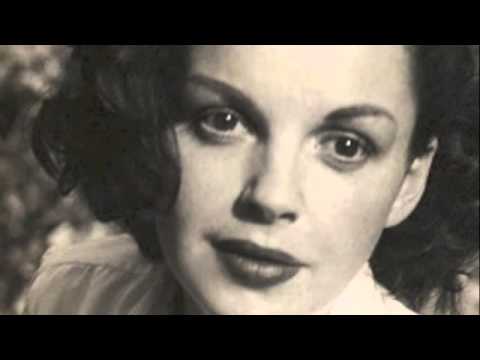

Jack Paar…Master Of Words – Storyteller Supreme
Jack Paar…Master Of Words – Storyteller Supreme
Earlier today, I posted an article celebrating the 59th Anniversary of Jack Paar’s debut as host of the “Tonight” show, on July 29, 1959. To celebrate his unique ability as a communicator, I thought you may want to hear special something I found a couple of years ago.
This is a very rare audio recording made by Jack Paar about a day in Hollywood, he spent with the great Judy Garland. Paar is a legendary storyteller and this is the best example of that ability, I have ever heard.
This is a bitter-sweet story which in a way, makes it all that much harder to tell, and although his touch is gentle, his intentions pure, and his heart is in the right place, some sad truths about Mrs. Garland come to light here.
I’ve wondered whether to post this or not, but given the quality of the tale, I have decided to go ahead with the following notes. First, Bless Her Heart! Judy Garland is without a doubt, one of the most talented people in the entire history of entertainment, which dates back to the Greek tragedies of 534 BC. Ironically, her life mirrored the joy and pain of those ancient productions almost to a tee.
For most of her life, she was not just a star, but a superstar, and that comes with an unbelievable burden, and a lot of insecurity. I think the only thing that was ever real to her was her children, as certainly everything else was surreal in the best and worst of ways.
God Bless You Judy! Bobby Ellerbee
https://www.youtube.com/watch?v=D31747Wy2YY
DISCLAIMER: Although we believe that Jack Paar was sincere in his intentions, he is factually off base on several points, and sensationalizes others. The gen…


The Best TV Book I Have Ever Read!
The BEST Television History Book I Have Ever Read!
The book is, “The Origins Of Television News In America”, by our friend Mike Conway.
In TV news lingo, “unpacking” is what a reporter does when he or she lays out the facts and timeline of their story. Although I have read the book twice, back-to-back, I am still “unpacking” this detail rich book, and go back to it almost daily.
The main narrative focuses on the little known story of how television news started at CBS. That is the center line on this highway, but there is not another TV history highway I have seen that goes more places than Mike Conway’s book!
All the networks, both radio and television, and all the historic events in the prewar, war, and postwar years are covered here in the greatest depth, and with more new information, than I have ever seen anywhere.
CBS legend Bob Schieffer says “Masterful research and a pleasure to read”. So say I, and to Mike Conway, I say…thank you for your years of dedicated research, and the huge effort it took to sort and present this information. You have given us new perspective on an amazing array of previously unrealized, domino-like occurrences in broadcast history. -Bobby Ellerbee
Some of my other favorites include “The Box” by Jeff Kisseloff, “The Best Seat In The House” by NBC’s Pat Weaver, “Beating The Odds” by ABC’s Leonard Goldenson, and “This Is CBS”, by Ron Slater.
http://newsinfo.iu.edu/news-archive/11723.html
An IU professor has discovered and reconstructed a lost first chapter in the history of television. In a new book, Mike Conway tells the stories of a mostly unknown group of CBS employees who worked in obscurity to develop a new way to deliver the news.
Six Decades of “Tonight”
THE TONIGHT SHOW: Six Decades of Television and Camera History
A look back at more than 60 years of the cameras that brought us everyone from Allen, Paar and Carson to Leno, O’Brien, Leno and Fallon
Included below: RCA TK10s, TK11s, TK41s, TK44s, TK47s, Sony HD 1000s and Sony HD 1500s and 1550s
I’ll begin by saying this article and its great pictures from the ”Tonight Show with Conan O’Brien’ would not have been possible without the help of cameraman Bruce Oldham, and our friends at NBCU Photo Bank.com. Bruce worked with Conan at NBC and is now with him at the Warner Brothers stage for his TBS show; in another Gallery article, we’ll show you that studio, too! Since this history comes all the way to modern times, we’ll see modern Sony cameras in action. There’s a lot of interesting information here on the current state of broadcast cameras that will be exciting and educational for all of us.
The Tonight Show was a creation of Sylvester “Pat” Weaver, first president of NBC Television, and has been on the air since 1954. It is the longest currently-running regularly scheduled entertainment program in the United States, and the third longest-running show on NBC after Meet the Press and Today.
When the show began it was broadcast live, but on January 12, 1959 the show began to be videotaped for broadcast later on the same day, although initially the Thursday night programs were kept live.
Color broadcasts began on September 19, 1960, during Jack Paar’s tenure as host, and below is the only known photo of a color camera on the Paar set in Studio 6B.
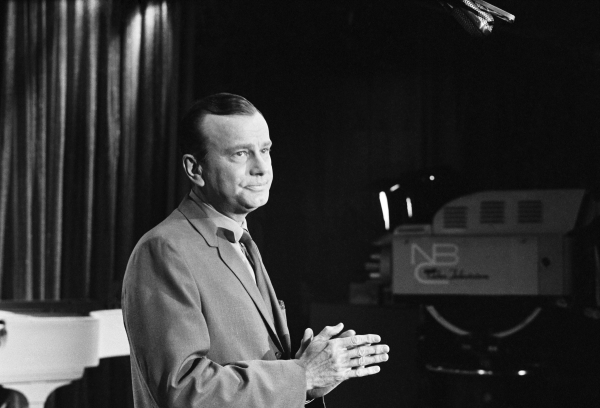
Photo courtesy NBCU Photo Bank.com. Copyright NBC. This image may not be archived, copied, leased or shared.
The Tonight Show has been hosted by Steve Allen (1954-1957), Jack Paar (1957-1962), Johnny Carson (1962-1992), Jay Leno (1992-2009, 2010-2014), Conan O’Brien (2009-2010), and Jimmy Fallon (2014-present).
The longest-serving host to date was Carson, who hosted The Tonight Show Starring Johnny Carson for 30 seasons, from the fall of 1962 through the spring of 1992. NBC’s Broadway Open House, which began in 1950, first demonstrated the potential for late-night network programming. The format for The Tonight Show can be traced to a nightly 40-minute program Allen hosted on WNBT, NBC’s New York station, starting in 1953. Network president Pat Weaver saw it, liked Allen and made a deal. In September 1954, it was renamed Tonight! and shown on the full NBC network.
Steve Allen (1954-1957)
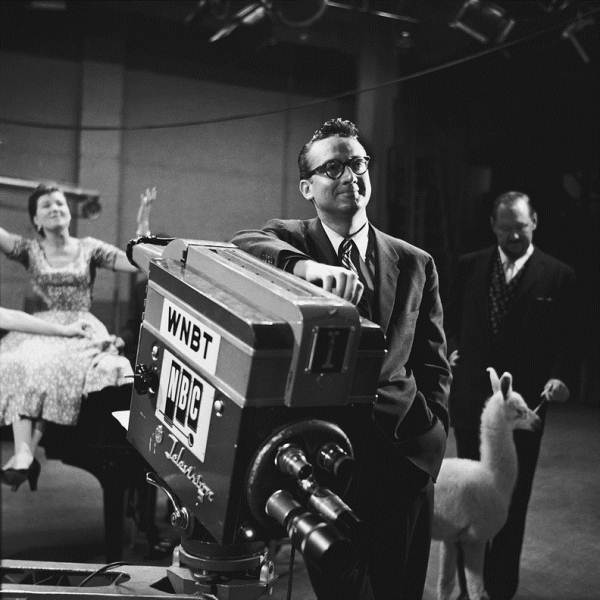
Photo courtesy NBCU Photo Bank.com. Copyright NBC. This image may not be archived, copied, leased or shared.
Above is Steve Allen with an RCA TK10 on the Tonight set at the Hudson Theater. The first Tonight announcer was Gene Rayburn. Allen’s version of the show originated such talk show staples as an opening monologue, celebrity interviews, audience participation, and comedy bits in which cameras were taken outside the studio. The show also had music, including guest performers and a house band under the direction of Skitch Henderson.
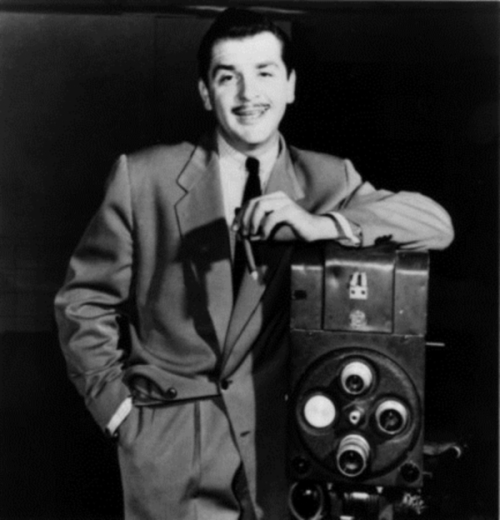
When the show became a success, NBC asked Allen to do a prime-time Sunday comedy-variety show in June 1956 and put him up against Ed Sullivan. This led him to share Tonight hosting duties with Ernie Kovacs during the 1956-1957 season. To give Allen time to work on his Sunday evening show, Kovacs hosted Tonight on Monday and Tuesday nights, with his own announcer (Bill Wendell) and bandleader, Kovacs was in essence, the first guest host, but Paar is credited with introducing that concept (and one of his early guest hosts was Johnny Carson).
Tonight! America After Dark (1957)
NBC wanted Allen to focus on his Sunday program in order to compete with Ed Sullivan, and thus Allen and Kovacs departed Tonight. The network changed the format of Tonight! into a late-night counterpart of Today, focusing on news and features. It was originally hosted by Jack Lescoulie, who was later replaced by Al “Jazzbo” Collins. Hy Gardner conducted interviews. The show was unpopular and a number of affiliates dropped the program.
The Jack Paar Era (1957-1962)
With Tonight! America After Dark a fiasco, NBC hired comedian Jack Paar to host a retooled Tonight that hewed more closely to Allen’s original formula of comedy, music and interviews. After Tonight Starring Jack Paar (which began the practice of branding the show with the host’s name) debuted in July 1957, the affiliates that had dropped the earlier show began to return. Paar’s original announcer was Franklin Pangborn, but he was replaced after a few weeks by Hugh Downs. Jose Melis, Paar’s Army buddy, led the house band. The program’s home was Studio 6B at NBC’s New York studios at 30 Rockefeller Plaza. (Remember this, for a great circle will be completed at the end of this article.)
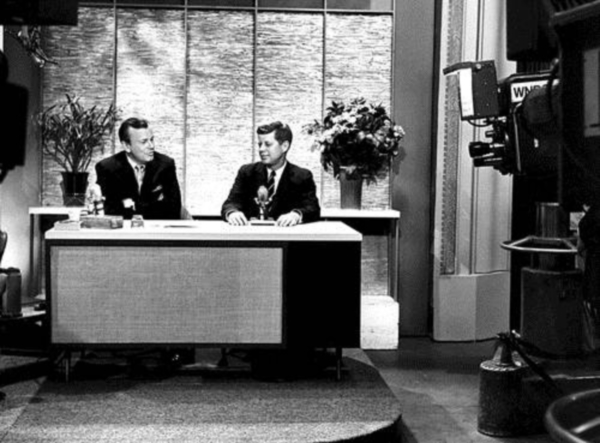
Above, Jack interviews future president John F. Kennedy as RCA TK11s beam it to the nation.
On February 11, 1960, Paar walked off his show after NBC censors edited out a segment, centered around a joke about a “water closet,” taped the night before. As he left his desk, an emotional Paar said, “I am leaving The Tonight Show. There must be a better way of making a living than this.” Paar’s abrupt departure left his startled announcer, Hugh Downs, to finish the broadcast himself.
Paar returned to the show on March 7, 1960. He strolled on stage, struck a pose, and said, “As I was saying before I was interrupted…” After the audience erupted in laughter and applause, Paar continued: “When I walked off, I said there must be a better way of making a living. Well, I’ve looked… and there isn’t.”
Paar left the show in March 1962, saying he could no longer handle the load of putting on the show five nights a week. The Jack Paar Show moved to prime time as The Jack Paar Program, and aired weekly, on Friday nights, through 1965. Jack was a favorite of mine…quite a sharp man!
The Johnny Carson Era (1962-1992)
Johnny Carson had been hired by NBC to replace Jack Paar, but contractual obligations prevented him from taking over Tonight until October 1, 1962. For all but a few months of its first decade on the air, Carson’s Tonight Show was based in NBC’s Studio 6B at 30 Rock. Ed McMahon was his announcer and sidekick. Below, we see Carson and McMahon in 6B, surrounded by TK41s.
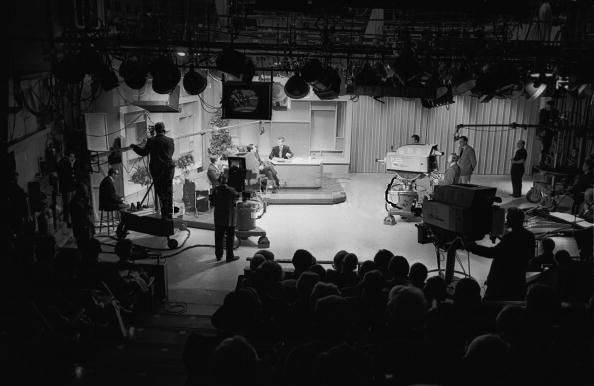
Photo courtesy Lytle Hoover’s Old Radio.com.
The TK41 images were so good, Carson kept them on his show until about 1971.
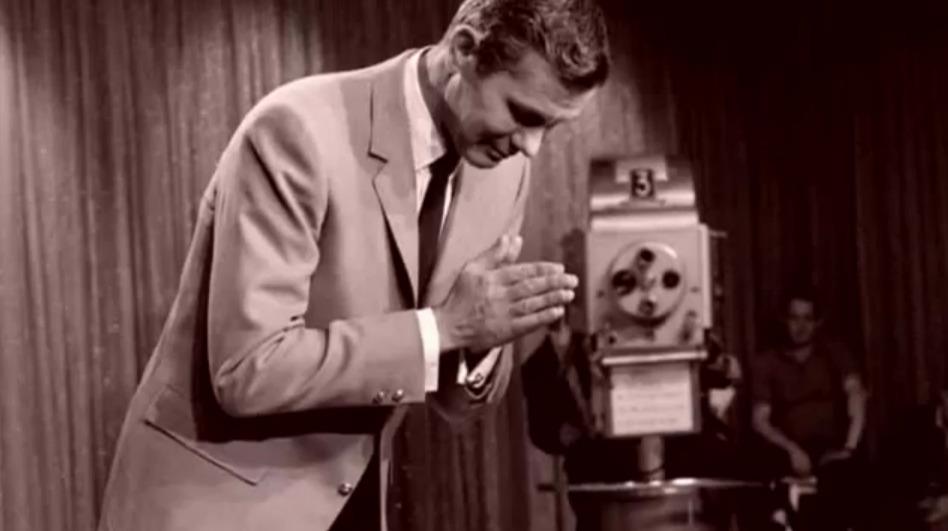
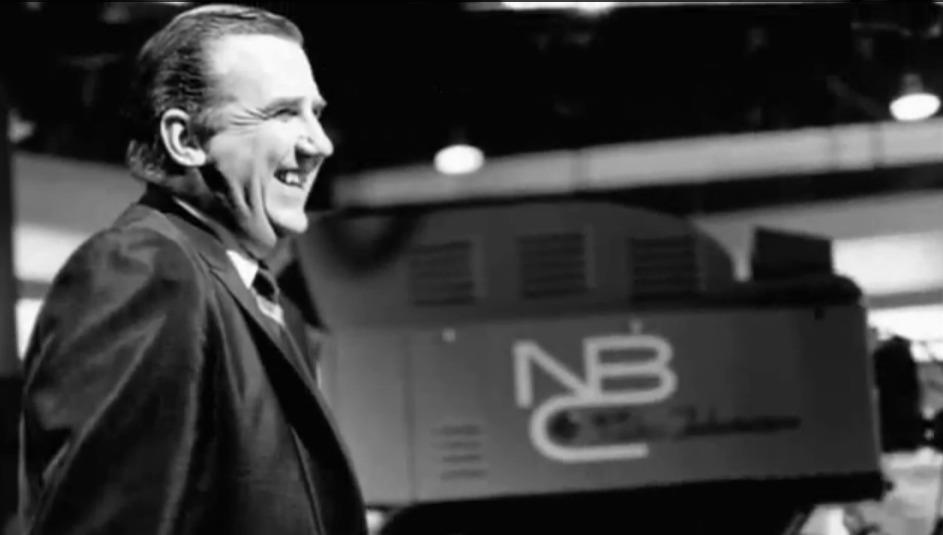

A year before the move to Los Angeles, NBC Studio 6B was equipped with 4 RCA TK44s. Had it been up to Johnny, they would have kept the TK41s till the move, but they needed to get the audience used to the new images the TK44s made.

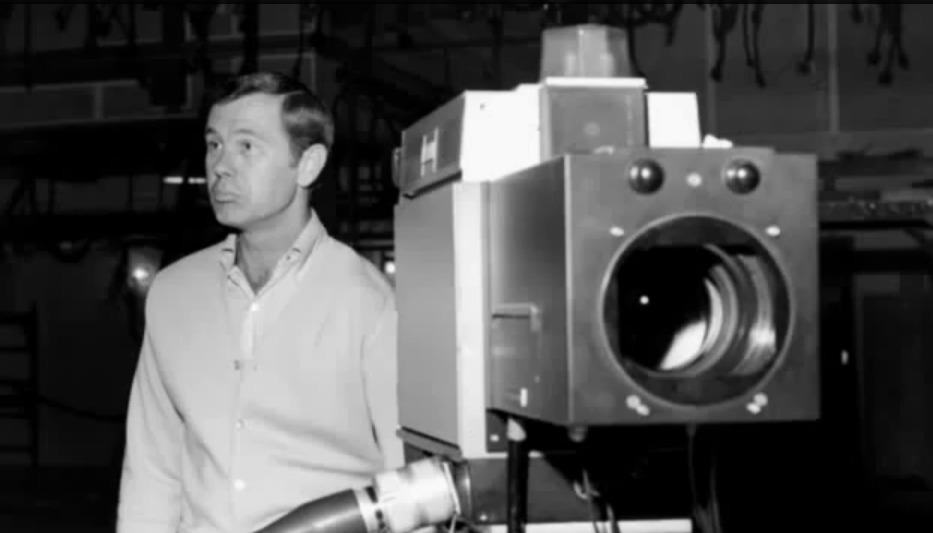
In May 1972 the show moved to Burbank, California into Studio 1 of NBC Studios West Coast (although it was announced as coming from nearby Hollywood). The Carson show originated from there for the remainder of his tenure. Below are four shots from the Carson show showing RCA TK44s on the set.
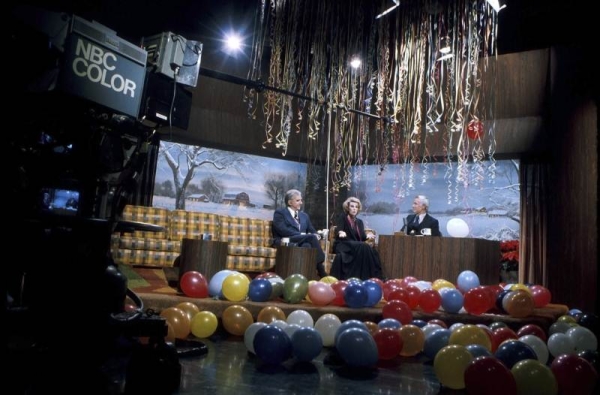
Johnny, Joan and Ed celebrate the Tonight Show’s anniversary in 1975.
Photo courtesy NBCU Photo Bank.com. Copyright NBC. This image may not be archived, copied, leased or shared.
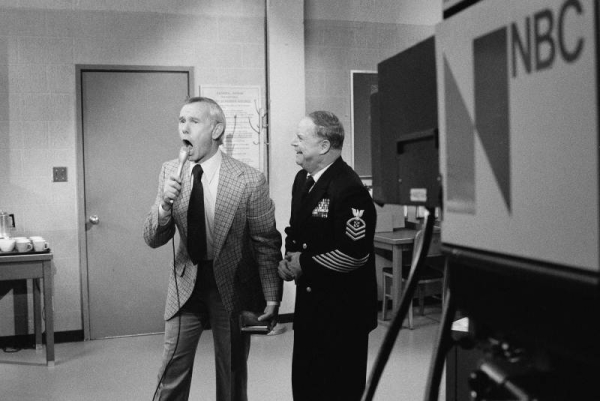
Remember this? In December 1976, Johnny marched next door and busted onto the set of CPO Sharkey to confront Don Rickles after finding out Don had broken his cigarette box while guest hosting. Note the new “Nebraska” logo on the TK44.
Photo courtesy NBCU Photo Bank.com. Copyright NBC. This image may not be archived, copied, leased or shared.
The First Jay Leno Era (1992-2009)
Johnny Carson retired on May 22, 1992, and was replaced by Jay Leno amid quite a bit of controversy. It was no secret that David Letterman, whose Late Night program aired on NBC after for Carson for years, wanted to host The Tonight Show when Johnny retired. Carson, and others, considered David his natural successor despite Leno having been Carson’s permanent guest host for several years. It was an ugly situation behind the scenes and Leno prevailed. Letterman, having had his heart set on Tonight, left NBC and joined CBS. The Late Show with David Letterman, airing in the same slot, finally made CBS a contender in late-night, a competition that continues even after Leno and Letterman have made way for Jimmy Fallon and Stephen Colbert.
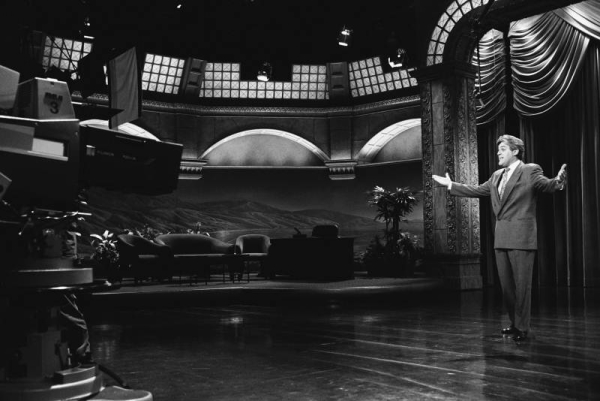
The photo above was taken the first week Jay took over the show, with TK47s now in use. The 47s came to Burbank in 1980 and were used till 1996.
Photo courtesy NBCU Photo Bank.com. Copyright NBC. This image man not be archived, copied, leased or shared.

Above is Jay Leno in May of 2004 doing his monologue to new Sony cameras…not yet HD, but that progression is shown below with a Sony HD 1000 camera on stage with Jay in June of 2007. The Sony HD 1000 is a great camera. In the business, it’s called a “hard body” camera…as you will see below, things have changed!
Photo courtesy NBCU Photo Bank.com. Copyright NBC. This image may not be archived, copied, leased or shared.
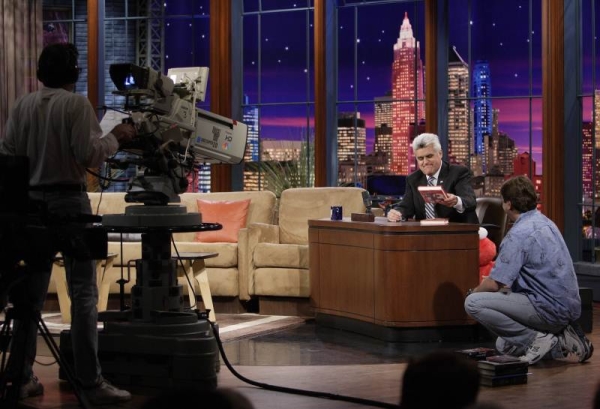
The Conan O’Brien Era (2009-2010)
On September 27, 2004, the 50th anniversary of the show’s premiere, NBC announced that Jay Leno would be succeeded by Conan O’Brien in 2009. Leno explained that in yielding to Conan, he wanted to avoid repeating the hard feelings that developed between him and David Letterman, and called O’Brien “certainly the most deserving person for the job.” I guess it’s the thought that counts, right? What was thought, at the time, to be the final episode of The Tonight Show with Jay Leno aired on Friday, May 29, 2009.
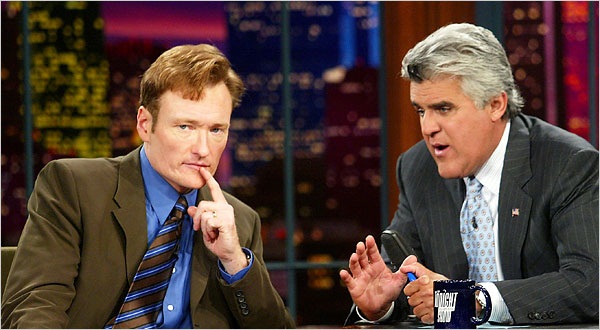
O’Brien replaced Leno as host of The Tonight Show on Monday, June 1 from a new studio in Stage 1 of the Universal Studios Hollywood back lot, ending an era (since 1972) of taping the show in Burbank. All the photos below were taken in that new multimillion dollar studio, where six floor cameras and four or more fixed-position audience reaction cameras were in use daily.
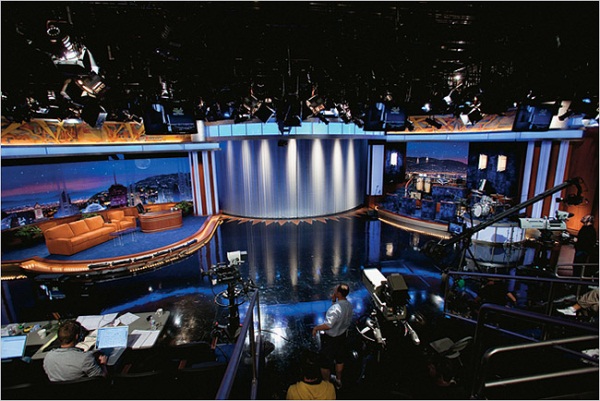
Above, a bird’s-eye view of the new studio and below, a view from the house audio console.
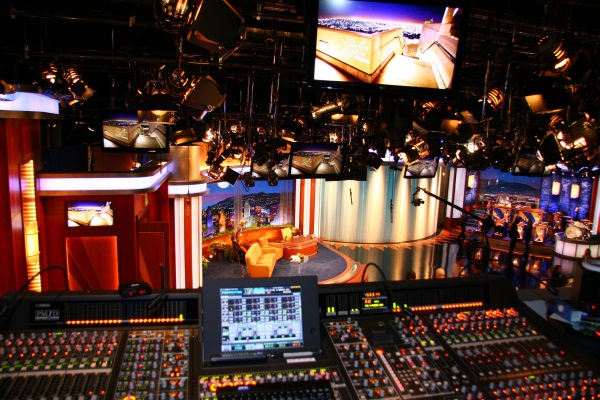
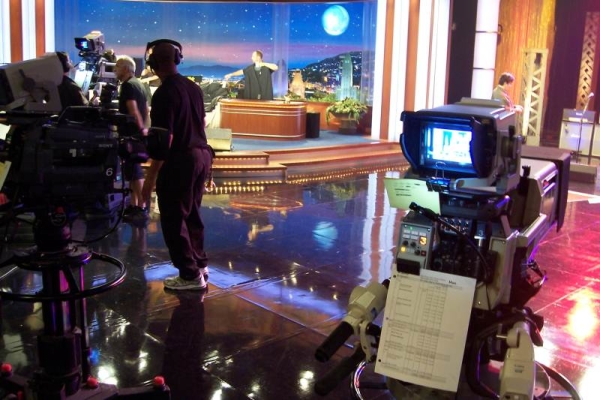
Now, let’s go on the stage floor at camera rehearsal. At first glance, it looks like there are big Sony studio cameras everywhere, right? Not so fast. There’s more below.
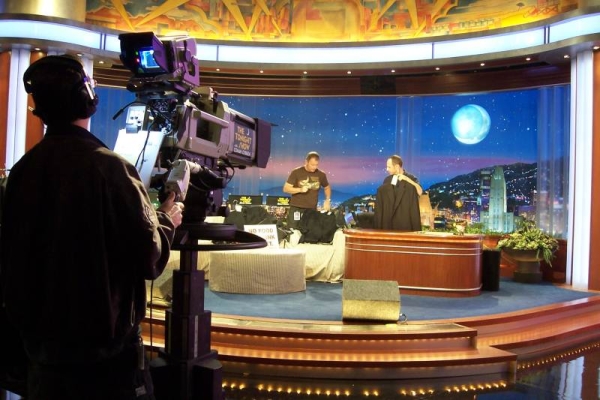
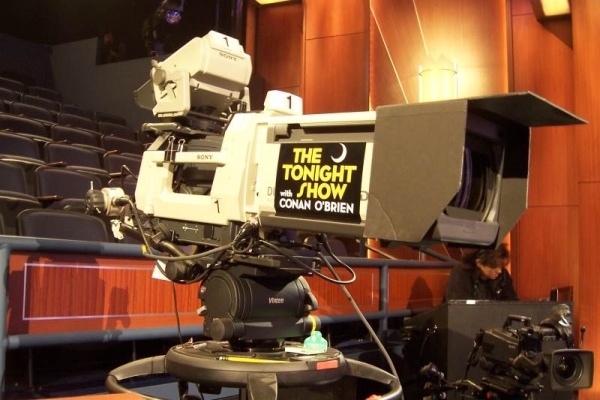
If you have not quite caught on yet, this should do the trick. Do you notice the difference in the light and dark parts of the camera? Well, that’s because these are two unique elements. These are “build up kits” that use small Sony HDC 1500 EFP cameras and HD lens adapters.

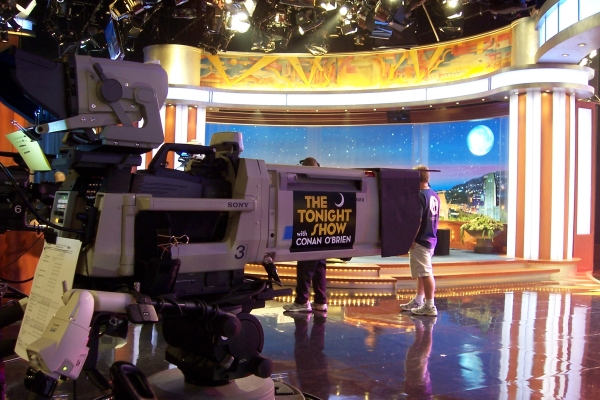
We’ll close with a couple of shots that show Bruce’s camera 3 (above) and the main interview set. His was one of the three large-lens cameras mounted on the new Vinten Quattro peds, and was equipped with a 72X lens. His camera did guest close-ups at home base and other zones. He has the exact same setup now and is on camera 3 of the Conan show on TBS. The other two large-lens cameras had 27X lenses and were cameras 1 and 2. All together, there were nine cameras with eight operators in the studio. Cameras 4 and 6 were the combo hand-held and ped-mounted. Camera 5 was the jib, and 7 and 8 were robo cams with one operator. There were also two Iconix lockoff lipstick cameras for audience shots.
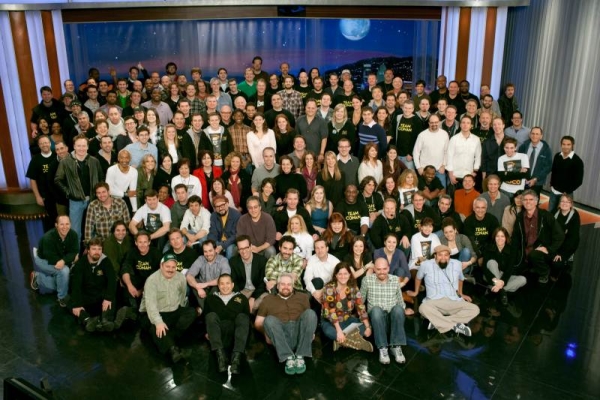
Here is the final class picture of The Tonight Show with Conan O’Brien…a great crew, and a lot of great talent here. Fortunately, TBS made a deal with Conan and most of these staff members are again “Coco”-nuts…including Bruce, who’s still on camera 3. Something I did not know about “how things work now” is that the camera operators and many other technical people were not NBC employees. They are called “day hires,” and that seems to be the way the new television business works…too many accountants in radio and television these days. Many thanks again to Bruce Oldham for the great photos.
CBS NY Master Studio List, New And Updated…1937- Present
CBS NY Master Studio List, New And Updated…1937- Present
First compiled by David Schwartz in April 1999, here is the updated list with some new revisions on July 26, 2016. Enjoy, comment, share and SAVE! -Bobby Ellerbee
_____________________________________________________
CBS Studios 1937 – 1964
Radio Studios, 485 Madison Ave. The original radio studios were number 1 through 6. Soon after, Studios 7, 8 and 9 were added with Studio 9 becoming the network’s major news studio. Eventually the studios in the building were numbered 1-20. Studios 31, 32 and 33 were also at 485 Madison, but were shortwave studios built to receive reports from overseas. The last radio broadcast from 485 Madison was July 25, 1964, and radio operations were moved to the new CBS Broadcast Center the next day.
Radio Studios, CBS Radio Building, 49 East 52nd Street. Just around the corner from the 485 headquarters building, at 49 East 52nd, CBS had a second radio building which had more studios that were numbered 21 through 29. Studio 21 was in the basement, 22 on the second floor, with 23 and 24 on the third floor. 25 and 26 were on the fourth floor and 27, 28 and 29 were on the fifth floor.
Studio 31 & 32 485 Madison Ave., Shortwave radio studios converted to TV Studios 1948-1964. This is where ‘Douglas Edwards With The News’ originally began, then moved to Leiderkranz Hall and later Studio 41.
Studio 41 to 44 Grand Central Studios, 15 Vanderbilt Avenue (3rd floor) used from the 1937 to 1964. Only 41 and 42 were production studios…43 and 44 were “control studios” used for switching, telecine and video tape.
Studio 50 (Ed Sullivan Theater) 1697 Broadway. CBS leased this for radio in 1936, and it was called Radio Playhouse #3. First radio show was “Major Bowes Amateur Hour”. First TV show was “Arthur Godfrey’s Talent Scouts”, December 6, 1948.
Studio 51 (Maxine Elliott Theater) 109 West 39th Street. Used by CBS 1944-1959 This was CBS’s first conversion of a theater from radio use to television use. Ed Sullivan’s “Toast Of The Town” was the debut show on June 20,1948.
Studio 52 (New Yorker Theater) 254 West 54th Street. Used by CBS from 1949 until 1975. Later became “Studio 54” nightclub.
Studios 53 to 56 Leiderkranz Hall, 111 East 58th Street. Used from 1950 to 1964.
Studio 57 (Peace Theater) 1280 Fifth Avenue
Studio 58 (Town Theater) 851 Ninth Avenue
Studio 59 (Mansfield Theater) 256 West 47th Street
Studio 60 (Lincoln Square) 1947 Broadway
Studio 61 (Monroe Theater) 1456 First Avenue CBS-Edge of Night (1956)
Studio 62 (Biltmore Theater) 261 West 47th Street
Studio 63-64 205 East 67th Street (DuMont /Metromedia Channel 5 studios 1 and 5) CBS. Shows from here were ‘First Hundred Years’ (1948), ‘Bilko’ (1955-56), ‘Edge of Night’ (1956 -1960) Wrestling show (studio 5) (Dumont, 1955),
Studio 65 (Hi Brown Studios) 221 West 26th Street
Studio 71 (Radio Studio 1) 485 Madison Ave.
Studio 72 (RKO 81st Street Theater) 2248 Broadway
_____________________________________________________
CBS TV Studios-1964 to mid 70’s
Studio 41-46 Broadcast Center. Began operation in 1964, radio on July 26; TV in August or September.
Studio 50 (Ed Sullivan) 1697 Broadway
Studio 51/54 (Hi Brown Studios) 221 West 26th Street
Studio 52 (New Yorker Theater) 254 West 54th Street. Used until 1975.
Studio 53 (Monroe Theater) 1456 First Ave
Studio 54 (Cort Theater). Used for the late night Merv Griffin show.
_____________________________________________________
CBS TV Studios Mid 70’s-present
Studio 41-46 Broadcast Center
Studio 50 Ed Sullivan Theater
Studio 51 New York Production Center, 222 East 44th Street (MPO, later EUE/Screen Gems)
Studio 52/53 Hi Brown Studios (also called Studio 51/54) unknown when numbering changed.
Studio 54 was originally a film studio. Patty Duke Show (ABC,1963-5) Bilko (CBS ,1956-9)
Studio 52 402 East 76th Street (used in the 1980’s)
_____________________________________________________
CBS Radio Playhouses
CBS Radio Playhouse #1 242 West 45th Street
CBS Radio Playhouse #2 251 West 45th Street
CBS Radio Playhouse #3 1697 Broadway (became Studio 50)
CBS Radio Playhouse #4 254 West 54th Street (became Studio 52)
CBS Radio Playhouse #5 109 West 39th Street (became Studio 51)
Notes:
CBS Studio 51 from the 1970s aka “The New York Production Center” at 222 East 44th Street, is EUE/Screen Gems (1973 to Present) Prior to 1973—it was used by MPO productions (as film stage, though it was used sporadically for videotape work). EUE/Screen Gems purchased the studio from MPO, and installed Fernseh KCU-40 video camera chains early 1970s, and it has been used for video since then.
CBS and ABC studios located at 205 East 67th Street, were actually the Dumont (Metromedia) studios.
CBS studio based at 2248 Broadway ultimately became Teletape “Stage 2” early 1970s (Sesame Street, Electric Company).
Himan Brown Studios (W. 26th St.) was used for both film and video production at various times, the Patty Duke Show (ABC, 1963-5) was filmed there as well as Bilko (CBS, 1955-59-second season). Currently owned by All Mobile Video.
Biograph Studio NY (807 East 175th St, The Bronx) Studio had been abandoned, but was revived around 1967. Car 54 (NBC, 1961-3), East Side/West Side (CBS, 1963-4), and Naked City (ABC, 1958-63)—all are filmed shows. This studio was also known as “Gold Medal Studios” in the late 1950s. Studio was abandoned in the 1970s, and burned in 1980.
Filmways Studios NY (246 E. 127th St.–built in a former MTA transit garage building in the late1950s.) The Defenders (CBS, 1961-5), and The Doctors and the Nurses (CBS, 1962-5), Hawk (ABC 1966), and Trials of O’Brien (CBS 1965-6) (All filmed productions). Films shot there include Butterfield 8, The Godfather, The Wiz. Studio was demolished in the 1980s.
Fox Movietone studios (460 W. 54th St at 10th Ave.) Two sound stages—the large one with a cyclorama and swimming pool under the deck. Three small scoring stages. UPI Movietone News operated in upstairs offices into the 1980s. Stages on ground floor operated as Fox until 1964, Manhattan Sound Studios until about 1968. Operated by F&B/CECO and Camera Mart (film equipment rental companies) in the 1970s and 1980s. Norby (NBC,1955), (strangely, shot on color film. Kodak was a sponsor) Adams Chronicles (PBS, 1976, recorded by EUE Video Services), Best of Families (PBS, 1977, recorded by Reeves Teletape). Later Sony Music Studios, demolished 2008. The original ‘Who Wants to Be a Millionaire’ was shot there in 1999 (at the time, ABC was contemplating purchasing the building). Notable films shot there: The Exorcist (1972), Kramer vs. Kramer (1979), Starting Over (1979), Sophie’s Choice (1982).
The Town Theatre at (either 840 or 851) 9th Ave was converted to a television stage and used by CBS, WNET-13 in the 1970s, and Teletape in the 1980s, Later Unitel. It was demolished and replaced by the Alvin Ailey Citigroup theater a few years ago.

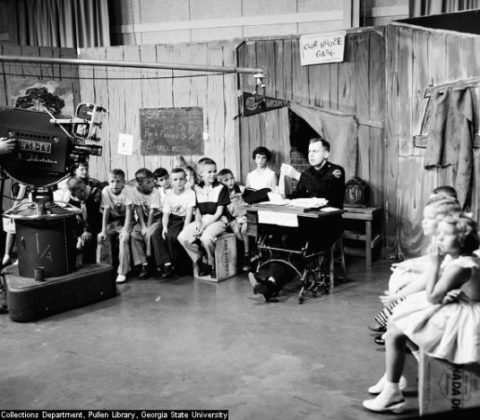
WSB-TV: The Early Years
Here are about 16 images from Georgia’s first TV station, WSB-TV in Atlanta, showing their RCA TK30s at work. The station signed on September 29, 1948 and use the TK30 till around 1954, when a few TK11s were added. In the early ’60s, WSB went to the RCA TK60s, then got the first delivered TK42s. WSB has been on the air more than 68 years and is a favorite of mine as I grew up watching it, but it amazes me how few photos there are to document those years. Unfortunately, this is a common story with many legendary broadcasters.
Before the photos, here is a great save from the 1950s and early 60s…the WSB color booklet that guests received when visiting White Columns.

I was on this show to celebrate my seventh birthday. It was The Clubhouse Gang with Officer Don. It later became known as The Popeye Club with Officer Don, and was the biggest kids’ show in the country. That’s part of how WSB-TV became the first station in the country to get RCA TK42s, as RCA believed shows such as The Popeye Club would give the cameras an excellent testing ground before they were ready for general release.
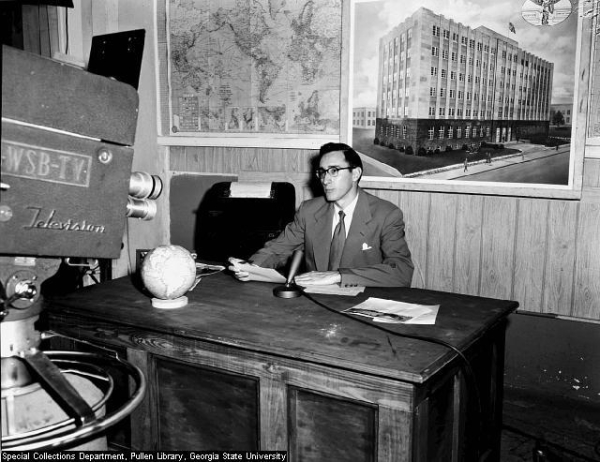
This is Ray Moore, long-time WSB news anchor.
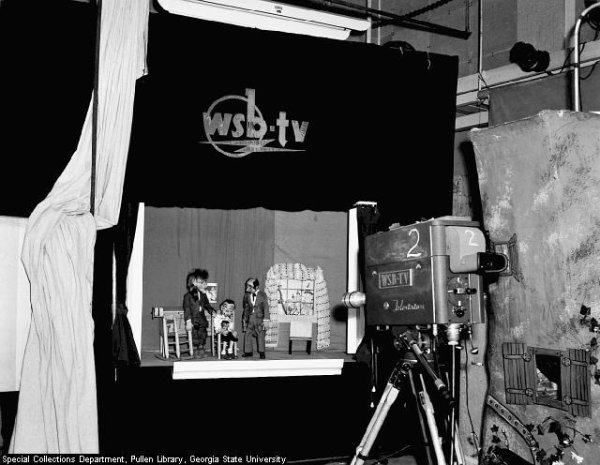
Before The Clubhouse Gang, there was The Woody Willow Show (above) with cartoons, and I watched it daily at 4pm as a 5-year old boy. Below are more photos of TK10s at work at WSB-TV Atlanta, which was the first TV station in the south, and began life as an NBC affiliate.

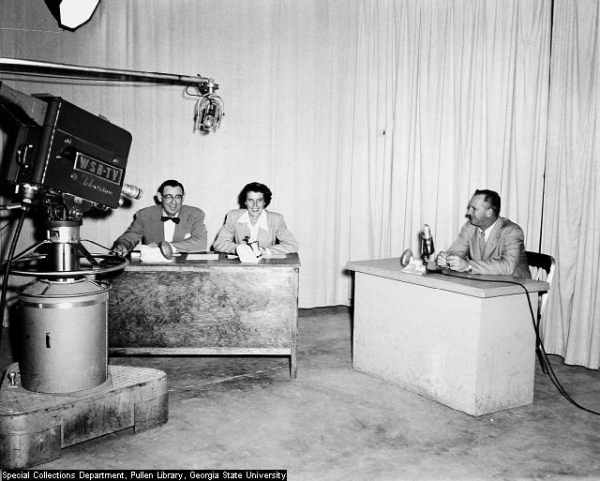
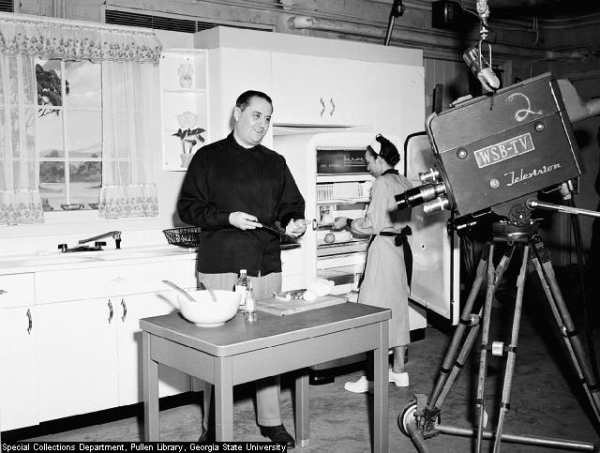

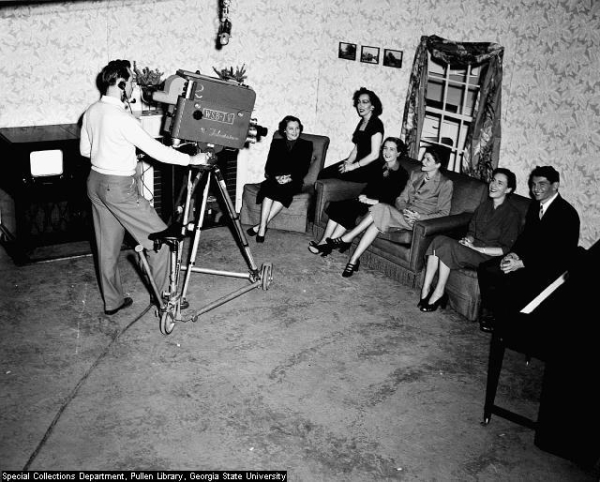
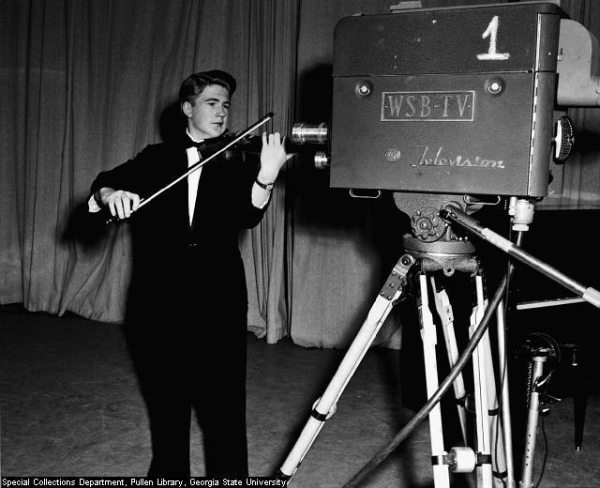

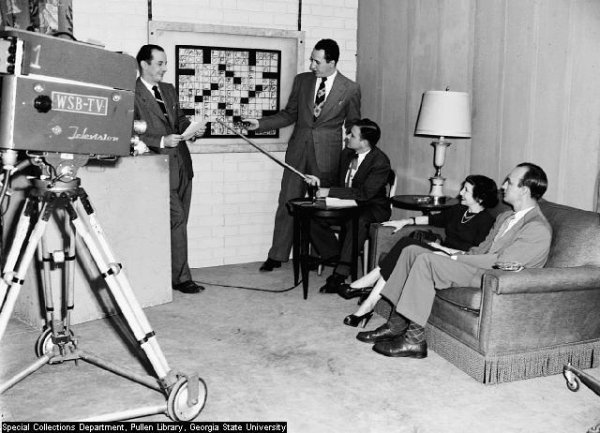

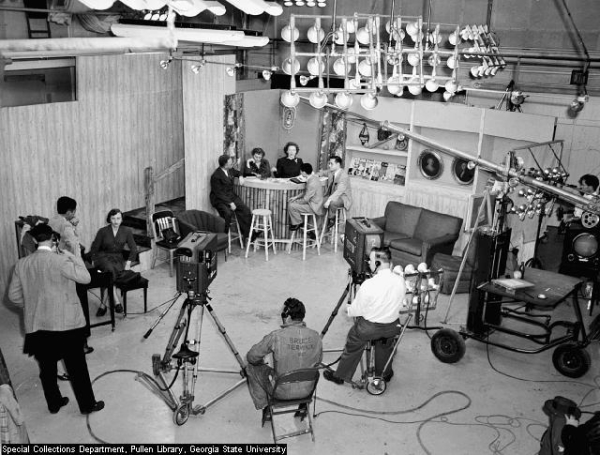
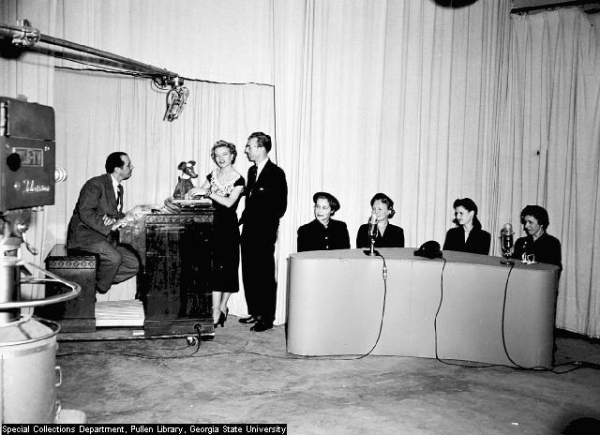

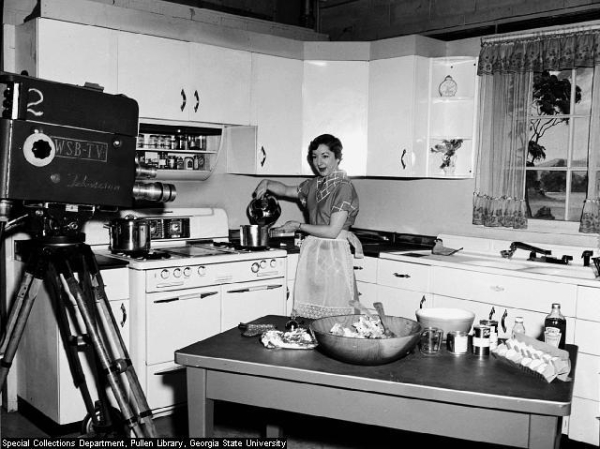
Happy Birthday….CBS Broadcast Center, Born July 26, 1964
On July 26, 1964, the first broadcast finally originated from a building CBS had owned since 1952. From ’52, until that first top-of-hour CBS Radio newscast, the facility had been designated the CBS Production Center, and was mostly used to store and build scenery, and provide office space for shows that worked from CBS theaters like Ed Sullivan’s.
Below is the CBS Press Release that introduces the Broadcast Center in great detail. It took some time for television to get set up there, and the first network offering is believed to be use of the new Studio 41 (old 41 and 42 were at Grand Central) for election night coverage in November of ’64, in black and white. Color came the next year.
CBS Press Release: November 25, 1964
CBS BROADCAST CENTER OPENS NEW ERA IN TELEVISION PRODUCTION; CONSOLIDATED FACILITY IS MOST ADVANCED IN THE WORLD
Electronic Wonderland Features Six Large “Floating” Studios and Computer-Controlled Technical Operations
A new era in the history of broadcasting has begun at the CBS Broadcast Center in New York, the most modern and the most efficient production facility of its kind in the world. Built around a core of six large studios with the industry’s most advanced technical support facilities, the Broadcast Center incorporates the latest achievements in technology for producing superior programs.
It implements designs and procedures formulated after years of world-wide research and development by CBS teams in every aspect of television broadcasting. A versatile, multi-purpose electronic wonderland where broad casts ranging from a news bulletin to a dramatic play to a gala musical comedy can be developed from first idea to finished program, the Broadcast Center contains a total of 495,628 square feet of floor space — more than the combined size of 10 standard football fields, goal line to goal line.
Situated on 11th Avenue between 56th and 57th Streets, the new CBS facility offers a tremendously increased potential for television programming originating in New York City. Each floor of the production area alone covers more than 100,000 square feet, an area 25% larger than the city block on which The Waldorf-Astoria Hotel is located. The opening of the Broadcast Center consolidates CBS studios and support facilities and services which previously had been dispersed in some 14 different locations in New York City.
Two off-premise studios — large theaters located at Broadway and 53rd Street and at Broadway and 54th Street (Studios 50 and 52), each with a seating capacity of close to 700 people — are still being retained to meet the needs of audience shows. Now located at the Broadcast Center are units of the CBS Television Network, CBS Owned television station WCBS-TV in New York City, the CBS Radio Network, the CBS News Division, and various central staff services.
Consistent with the broadcast Center’s announced goal of providing the highest quality of television, its six large studios — all situated on a single floor — are modern miracles of design. The floor of each studio is a concrete slab, which together with the walls is supported by coil springs and neoprene pads. Thus, each studio is, in effect, a separate “floating” structure. This feature plus buffer corridor areas around each studio in addition to ingenious soundproofing insure acoustical isolation. Another innovation in the design of the studios is a lighting grid structure which allows lights to be hung and adjusted from over head walkways without disturbing activity on the floor.
Adjacent to each studio is a control room containing the latest related technical advances of the electronic medium. While the six studios in the CBS Broadcast Center vary in size, each of the six control rooms is the same. Specially designed to assist and enhance the creative activity in the studio which it services, the control room is so arranged that the entire production team maintains continual visual contact with the program director. In a departure from common practices, the control room does not have a window opening overlooking the studio. Each control room incorporates a highly advantageous concept in functional design for broadcasting by providing separate picture, sound and production control areas, plus easy access to the studio itself. These areas can be separated from one another by sliding glass panels, yet all are within line-of-sight with the program director.
All technical equipment in addition to telecine and videotape machines, whose physical presence is not actually required in the control room, has been removed to a central maintenance area. Yet, by remote control techniques, each member of the production team retains full control over those technical elements of the production for which he is responsible. Directly below the floor where the studios are located in the Broadcast Center is the extensive Central Technical Area.
Here is housed the vast amount of highly complex and sophisticated technical equipment needed to bring the broadcast program to the homes of viewers across the nation and, with the aid of space satellite relays, to viewers in other parts of the world. Notable among this array of technical equipment are the Broadcast Center’s computers and the switching systems of unprecedented magnitude, complexity and efficiency in broadcasting. These systems provide the capability to store information on the scheduled use of facilities and the details of the broadcast schedule, and the capability to route all audio and video signals and communication circuits to their proper destination.
Additionally, the systems provide the means, where needed, to start and stop videotape machines and film and slide projectors. From one technical viewpoint, television broadcasting is a continual process of accurate scheduling, precision timing and error- free coordination of the separate elements that make up a program: film, tape, live pickup, commercials, announcements and many other elements.
At the Broadcast Center, this basic broadcast process is now controlled by computers assigned to the program continuity studios where pre-recorded network and local programs and local station breaks are originated. Two computers have been installed. Each has the capacity to store every bit of program scheduling information needed for the en tire broadcast day and, at the precise moment, automatically to select correctly the program element to go out on the air. Still another use of the computers is to record the studio lighting levels worked out during rehearsal for identical repositioning of the lighting controls during the broadcast of the program. Each computer, by itself, can handle all the basic network and local station broadcast schedules. The installation of two units provides backup protection should the need arise, especially since there is a continuing automatic interchange of information between the two computers.
As now constituted, the Broadcast Center comprises three inter connected structures. The first is an eight-story structure. It houses the Music and Record Library, offices of WCBS-TV News, offices of CBS Films Inc., CBS Data Processing, and CBS News production and administrative offices and reference library. The second structure is six stories. It contains offices of the CBS Television Network Operations Department, the CBS Radio Network Operations Department offices and one of the Broadcast Center’s five radio studios, WCBS-TV Program Department, CBS Television Network show units and accounting offices, four film screening rooms, WCBS-TV film editing facilities and the CBS Television Network sound effects department. Also contained in this structure are the cafeteria and stationery shop.
Central to the third structure are the six television studios, the largest of which has an area of 8,45O square feet and the smallest 3,260 square feet, plus their complete support facilities. In this building, too, are the CBS News newsroom, correspondents’ and executive offices, and film editing and viewing facilities. Immediately adjacent to the newsroom are four radio news studios and the television Flash Facility where bulletins are originated. Also In the building are the Television General Technical Area; storage, staging and maintenance area for equipment used in remote pickups; film distribution; scenic design area and construction shops and storage facilities; dressing rooms, wardrobe and makeup rooms; rehearsal halls; film and videotape storage rooms, and emergency power plant. Geared to serve most efficiently the needs of current production of the CBS Television Network, the Broadcast Center was designed with a flexibility factor so that it will have the capacity to meet future expanded physical and technical requirements.
Also, the Broadcast Center is designed for both black-and-white and color program requirements. The original building of the Broadcast Center, ideally located in midtown Manhattan but out of the city’s congested traffic pattern, was acquired by CBS in l952 with the thought of ultimate conversion to a centralized broadcast plant. It was utilized at once for rehearsal halls, scenery construction and storage, and production and administrative offices. A series of studies was undertaken as to the feasibility of such a plan and, after every aspect of the evolved master plan had been fully investigated and reported on by experts, the go-ahead signal was given by top management.
Among these features were massive truck ramps connecting the original floors to a loading dock on the street level. The ramps were retained to provide access to the studios on which scenery and props from the shops and storage areas could be hauled with ease by trailers and battery-powered tractors. Moreover, the extra-sturdy steel and concrete construction of the original building proved to be well suited for reinforcement to support the new, higher roof which was built over the studios.
Also, by careful scheduling to take advantage of available space in the original structure, interior reconstruction was able to precede with minimal interference to the CBS operations already underway in the “Production Center,” as the building was known at the time. When plans for converting the 57th Street property into an integrated television complex were first announced, CBS envisioned that the completed Broadcast Center would provide the CBS Television Network with “by far the finest television facilities in the world.” That vision has now become reality.

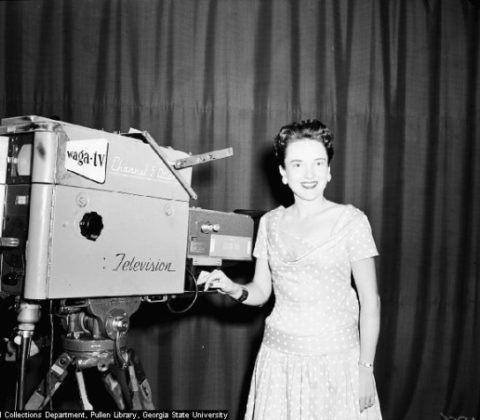
WAGA-TV: The Early Years
This was Atlanta’s second TV station. It was a CBS affiliate until the late 1980s. WAGA had TK30s and later TK11s, but never had TK60s. The station bought Norelcos in 1966 or so.
Like WSB, there are virtually no photo archives left, but here’s all that I know of. The station is now a FOX affiliate and was part of the mass change that came to Atlanta 20 or so years ago when all the stations switched networks. WXIA was ABC; now it’s NBC. WSB was NBC; now it’s ABC. WAGA was CBS; now it’s FOX. A station that was an independent became the CBS affiliate.
Here are more photos of TK30s at work at WAGA-TV. Photos are from the Special Collections Department, Pullen Library, Georgia State University.

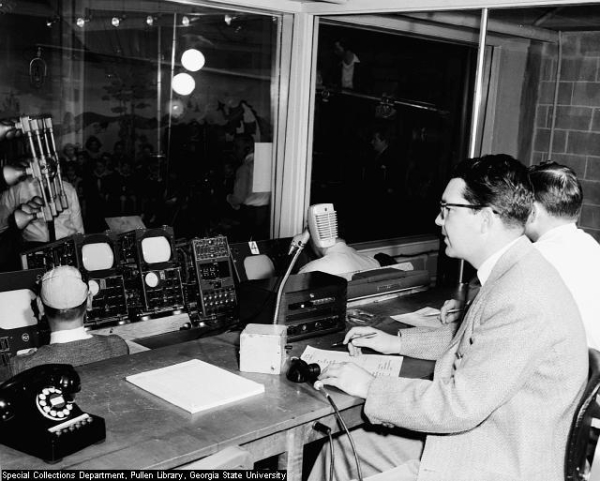
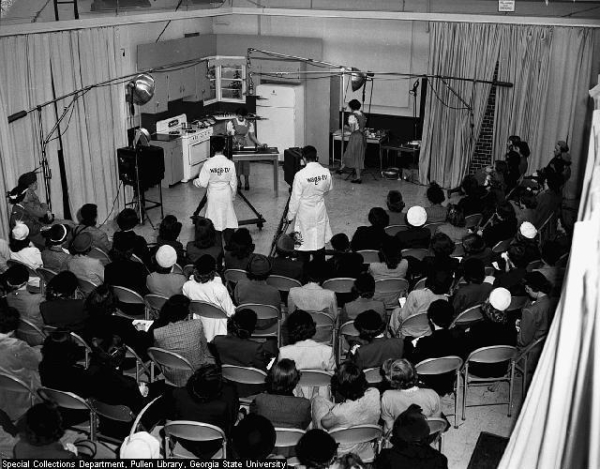
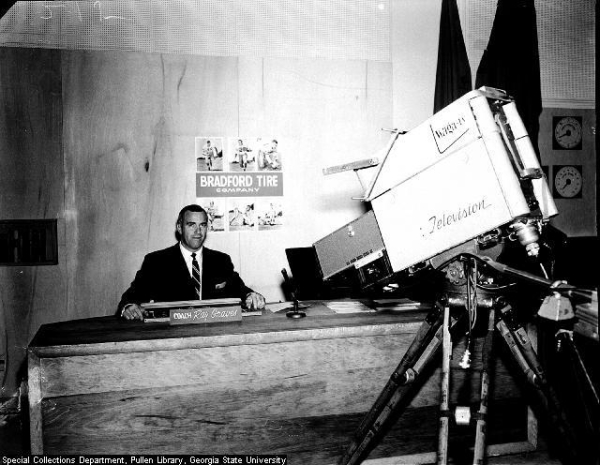
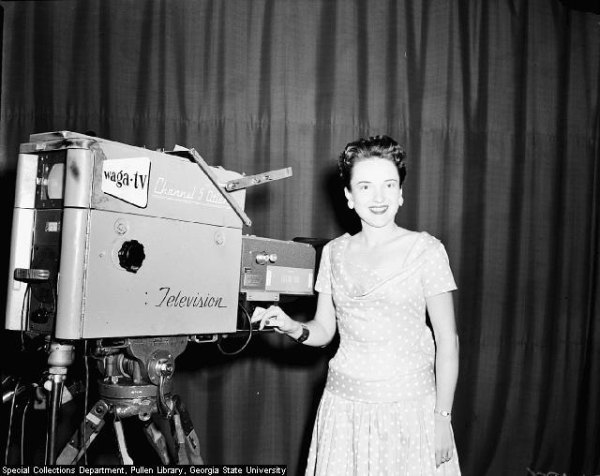
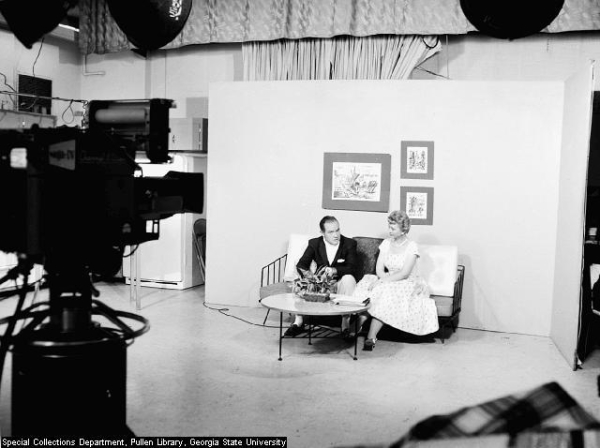
Bob Hope being interviewed at WAGA’s Atlanta studio
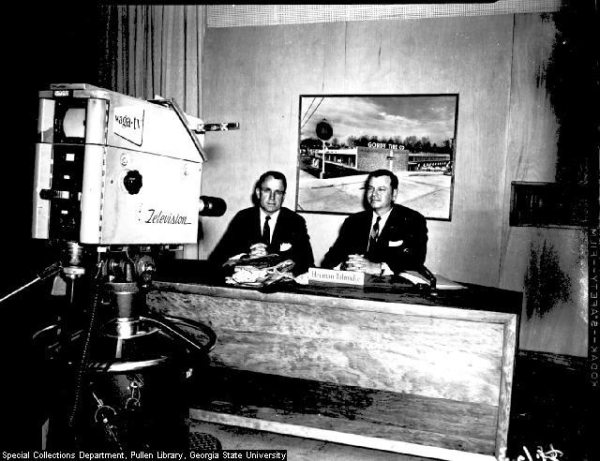
U.S. Senator (and former Governor of Georgia) Herman Talmadge being interviewed.
July 25, 1964…CBS Radio Bids Farewell To 485 Madison Avenue
(Photo above: CBS News Studio 9 with Murrow in suit and the short man in the background is news director Paul White. On the right, Douglas Edwards looking at wire copy.)
On September 18, 1927, the CBS Radio Network, with 18 affiliates went on the air from their studios in The Steinway Building near Carnegie Hall on West 57th Street.
Exactly two years later, CBS Radio moved into the new 485 Madison Avenue building on September 18, 1929.
On July 25, 1964, the last broadcast from the heart of CBS Radio News…Studio 9, was a hosted by Steve Rowan, and the next day, Rowan was the first to broadcast from the new CBS Broadcast Center. At this link is the 2 page CBS press release. http://donswaim.com/cbs-radio-moves-1964.pdf
That last show from 485 Madison, “Farewell To Studio 9” was historic in every way, and included clips from the many world shaping newscasts, and the most iconic newscasters this country
has known, including Edward R. Murrow, and many more that you can hear at this link to that last show.
http://www.oldtimeradiodownloads.com/historical/farewell-to-studio-9/farewell-to-studio-9-19xx-xx-xx
Some Interesting History: When 485 Madison Avenue was first built, CBS occupied only the upper floors. As need grew, CBS expanded throughout the building. Originally, there were six studios.
Studios 1, 2, and 6 were on the 22nd floor. Studio 1 was reached by a staircase as its floor was higher in order to accommodate the higher ceilings of Studios 3 and 5 which were directly underneath.
Studios 3, 5, and 4 were located on the 21st floor. Master Control and the upper part of Studio 1 occupied the 23rd floor.
Studios 1 to 6 were remodeled in the mid 30s reflecting acoustic enhancements unknown when first built. Suspended light fixtures became recessed, sound insulation, wooden panels, and rubberized flooring were among the improvements. Also in the mid 30s, Studios 7 and 8 were constructed on the 3rd floor of 485 Madison Avenue.
Studio 9, which was the news studio and the news department were located on the 17th floor. CBS also had radio studios at 49 East 52nd Street, just around the corner from 485 Madison.
CBS television studios were also in the process of moving to the Broadcast Center including 41 through 44 at Grand Central. Studios 53 to 56 at Liederkrantz Hall, 111 East 58th Street were also moving to the Broadcast Center. The corporate offices later moved from 485 to Black Rock which opened in 1965 at 51 West 52nd Street. Happy Birthday to the CBS Broadcast Center! -Bobby Ellerbee
July 25, 1959…Nixon-Khrushchev “Kitchen Debate” Tape Airs In US
July 25, 1959…Nixon-Khrushchev “KItchen Debate” Tape Airs In US
The Kitchen Debate was a series of impromptu exchanges (through interpreters) between then U.S. Vice President Richard Nixon, and Soviet Premier Nikita Khrushchev in the “kitchen of a modern American home” on display at the opening of the American National Exhibition at Sokolniki Park in Moscow on July 24, 1959.
Using an RCA TK41 color camera, the debate was recorded on Ampex color videotape, a new technology recently pioneered in the U.S., and Nixon made reference to this fact. The exchange was subsequently rebroadcast in both countries. Khrushchev was skeptical of Nixon’s promise that his part in the debate would be translated into English and broadcast in the U.S., but it was.
In the United States, three major television networks broadcast the kitchen debate on July 25. The Soviets subsequently protested, as Nixon and Khrushchev had agreed that the debate should be broadcast simultaneously in America and the Soviet Union, with the Soviets even threatening to withhold the tape until they were ready to broadcast. The American networks, however, had felt that waiting would cause the news to lose its immediacy. Two days later, on July 27, the debate was broadcast on Moscow television, albeit late at night and with Nixon’s remarks only partially translated.
Below, Ampex president Phil Grundy, Khrushchev and Nixon watch the playback of the just recorded remarks. Khrushchev was shown how to operate the controls of the recorder, rewound the tape and played it back.
Nixon persuaded him to let it be seen in the United States, but Khrushchev insisted that it be translated in full and played unedited. To make sure that it got out of the Soviet Union, Ampex president Philip Gundy rushed back to his hotel with the tape, wrapped it in a dirty shirt and booked the first flight home.
By the time it was broadcast the following day, American newspapers had reported the event as an exchange acrimonious enough to start World War III. What viewers actually saw, though, was the two leaders in earnest and sometimes animated discussion, but by no means ready to launch missiles. The tape has been hailed as a milestone in communication as well as an historical document in its own right. The link above is to one of the few versions with captions. Enjoy! -Bobby Ellerbee
June 1940….Television’s 1st Convention & 1st Network Broadcast
In a spirit of cooperation, competitors RCA, GE and Philco teamed with AT&T to televise the Republican National Convention in Philadelphia. It was a television first in more ways that one. Not only was this the first time TV had covered a political convention – this was also the first ever network to cover 3 cities at once.
RCA’s W2XBS in New York City had sent broadcasts of “Meet The Wife” to General Electric’s W2XB in Schenectady, in January of 1940, which was in essence, the first network. RCA had also sent separate broadcasts to Philco’s W2XE Philadelphia, but this event, now included all 3 stations. Many historians call this the first real television network, as it endured though the WW II television black-out, and began again in April 1944 with the broadcast of “The Voice Of Firestone Televues”.
The NYC-Schenectady leg was handled by existing AT&T equipment, but to get the intact images to NYC from Philadelphia required AT&T adding amplifiers every 5 miles of the 108 mile route, so a lot of time was spent in manholes in early June.
In Philly, there were only about 100 receivers in use, and most of those belonged to Philco and their executives, but it is reported that up to 2,000 a day watched the coverage on 60 sets RCA had installed at a museum next to the convention hall.
Were it not for a dark horse candidate winning the nomination, the convention may not have made many memories, but Wendell Wilkie came out of nowhere to defeat former President Herbert Hoover, Senator Robert Taft, Thomas Dewey and two others to win the nomination at 2 AM, on the 6th ballot.
The legendary Worthington Minor, who was just starting his TV career, watched and said unlike the radio coverage, TV captured the tension on the delegates faces as they voted.
That year, FDR was nominated for his 3rd term in office, but television could not take us there, as the convention was in Chicago, and at the time, there was no coaxial connection between the midwest and NYC. On election night, both NBC’s and Dumont’s stations broadcast election results locally. -Bobby Ellerbee
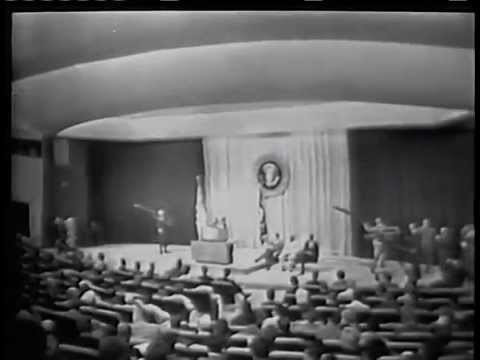

July 23, 1962…First World Wide Television Broadcast Via Telstar
On a Monday afternoon on this date in 1962, CBS News anchorman Walter Cronkite entered NBC’s studios at 30 Rockefeller Plaza to co-host this historic broadcast with NBC’s Chet Huntley. ABC’s Howard K. Smith was at the UN Building. The twenty minute broadcast from the US to Europe was slated to start at 3 PM eastern, but the Telstar signal was acquired a few minutes early so they started then.
Aside from the historic transmission event, the sight of Cronkite and Hunley working together is nothing less than extraordinary.
As you will see, there are shots fed into NBC from all across the country including Cubs baseball from Chicago, President Kennedy in Washington, the Golden Gate Bridge in San Francisco, Mt. Rushmore, the Statue Of Liberty, buffalos on the planes, The Mormon Tabernacle Choir from Utah and much more.
In Europe and Canada, 100 million viewers tuned in and it seems that the baseball game was their favorite part. A few hours later, the tables would turn and Europe would broadcast live to the US with Howard K. Smith joining Cronkite and Huntley at NBC, and all three networks would air this live, simultaneously. -Bobby Ellerbee